The TF2 Train, HO Scale
Recreating the TF2 train as an HO Scale model. Some liberties taken.
Project Goal: Recreate the classic TF2 Train seen in Well and other maps.
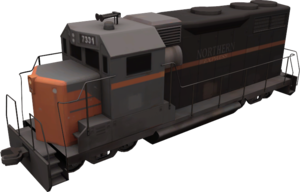
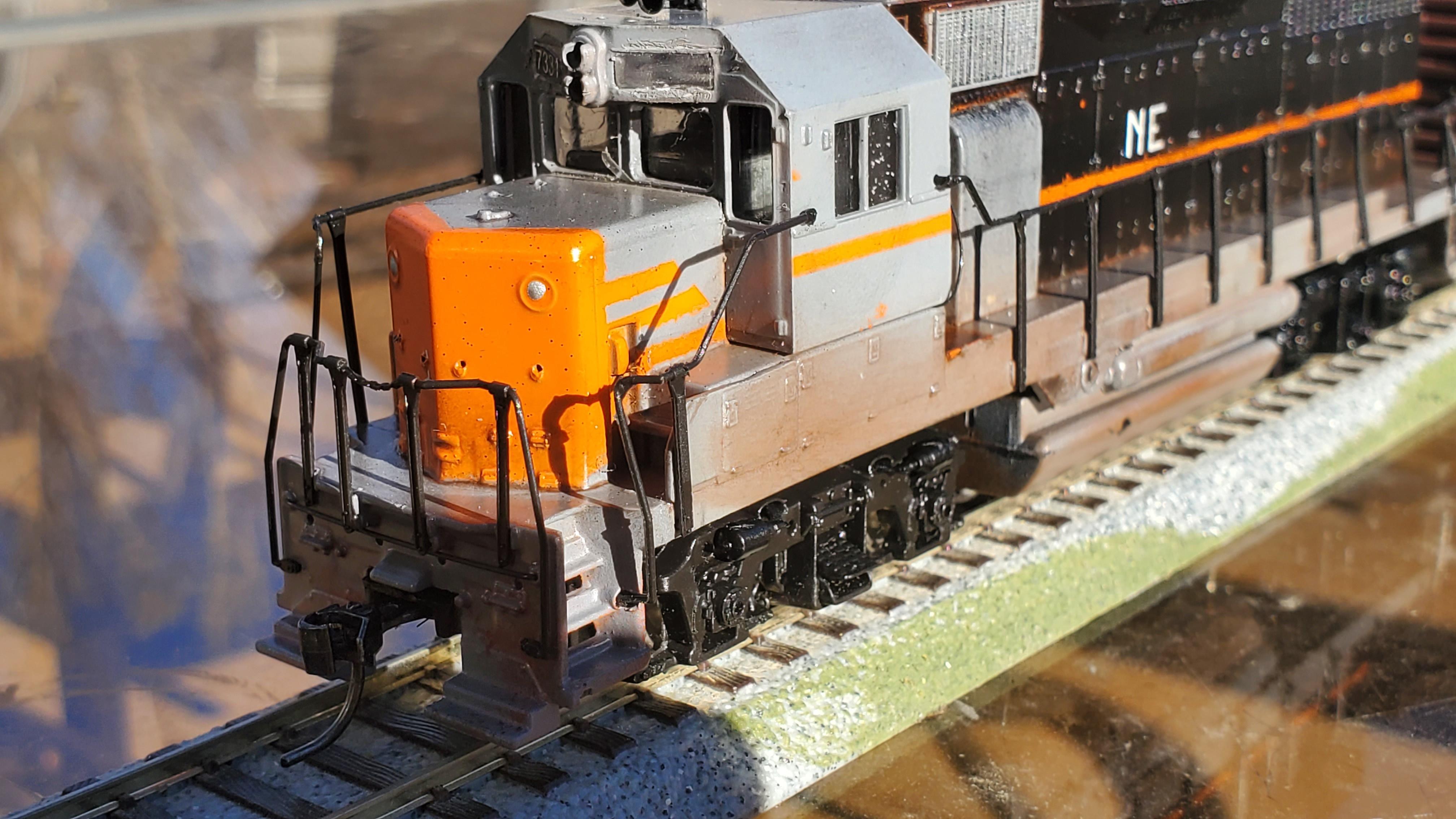
Day 1 (Half Day)
This project starts with an existing locomotive: an undecorated Bachmann Plus EMD GP35. Not the flashiest locomotive, but a nice cheap start for a project like this. I obtained this last weekend from the local youth club, gave it a test run, then shelved it till the jam start.
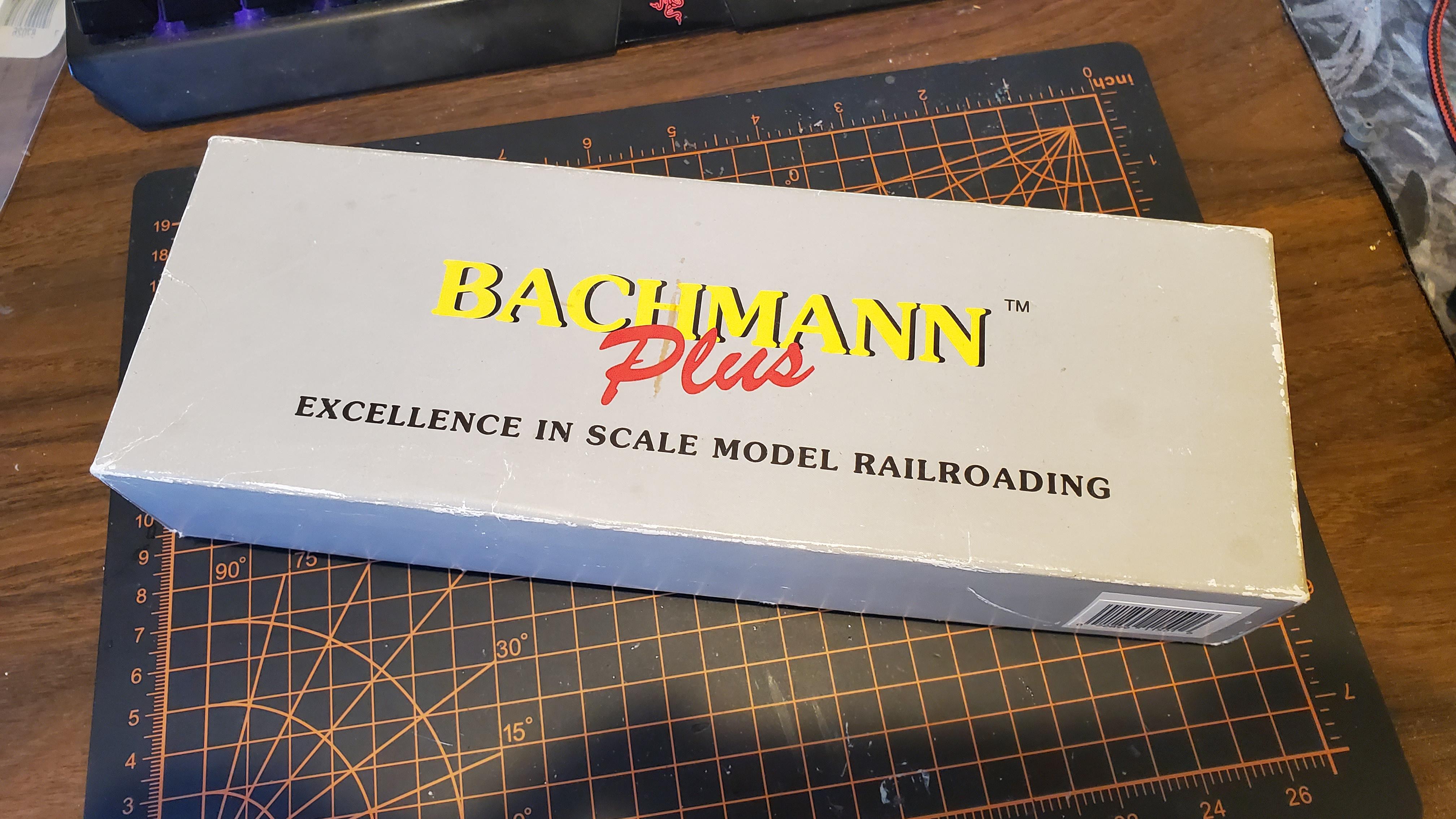
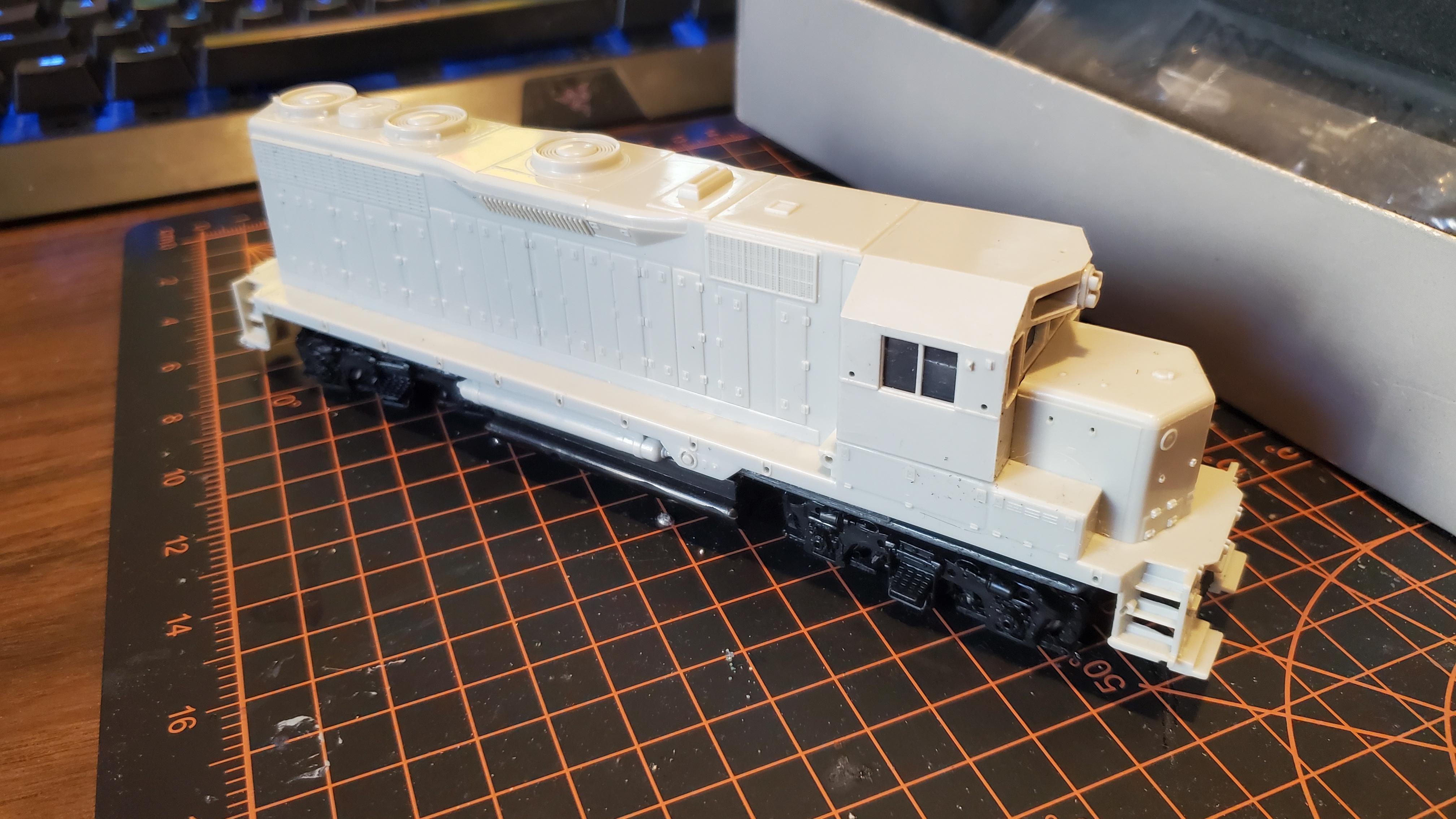
Today's goal was to implement all the electronics, and prep the locomotive for painting tomorrow, at the club. The decoder I started with was a DigiTrax DH123D. An older decoder, but considering its been sitting in a box for about 8 years, what better time to use it than now?
Taking the shell off the locomotive reveals an interesting approach to the inner workings of a model train:
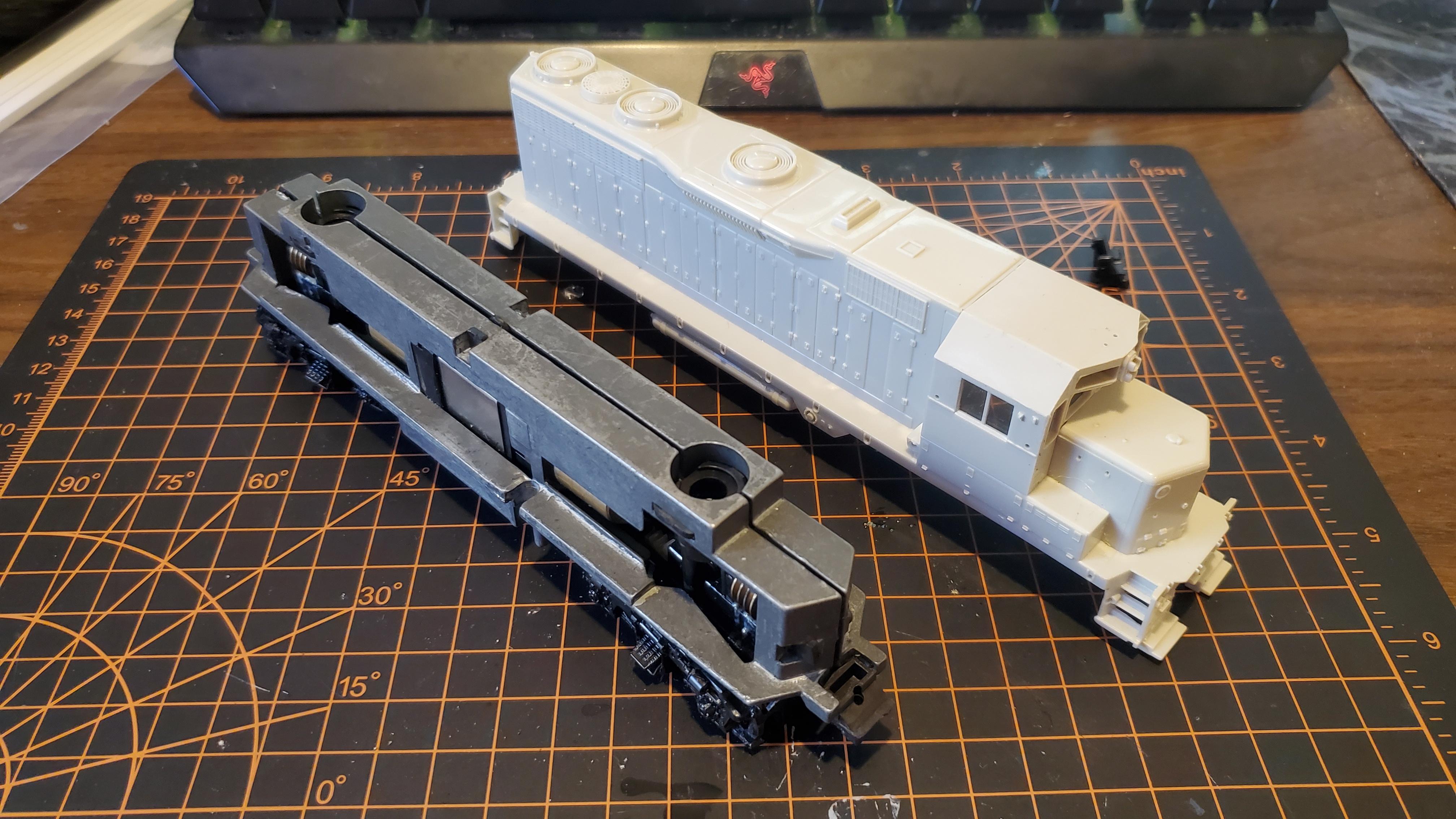
Older Bachmann locomotives, such as this one, consist of two driven trucks, driven by a can motor encased inside two large conductive weights. Power is passed from the tracks to the engine via these weights; the trucks contain little tabs that rub against the weight, transferring electricity through them to tabs on the motors. Some screws with rubber spaces hold everything together, making dismantling pretty easy.
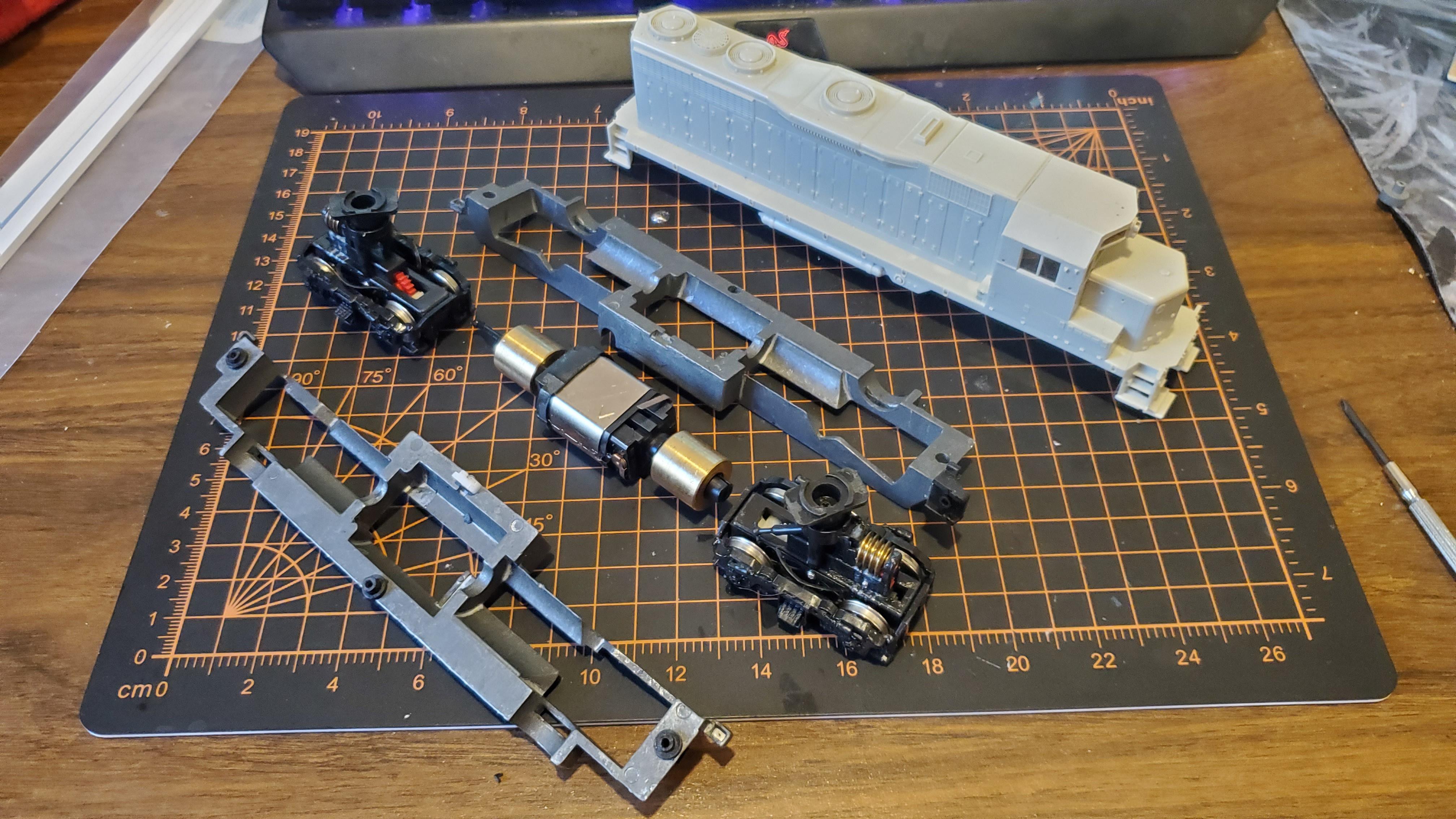
First step of decoder installation was getting the leads (orange + grey) onto the motor. I cut the motor tabs off and soldered the wires to their point of origin. If you ever find yourself working on a similar mode, dont remove the caps, as they contain a spring that holds the whole thing together. I actually had to solder one cap into position as I went.
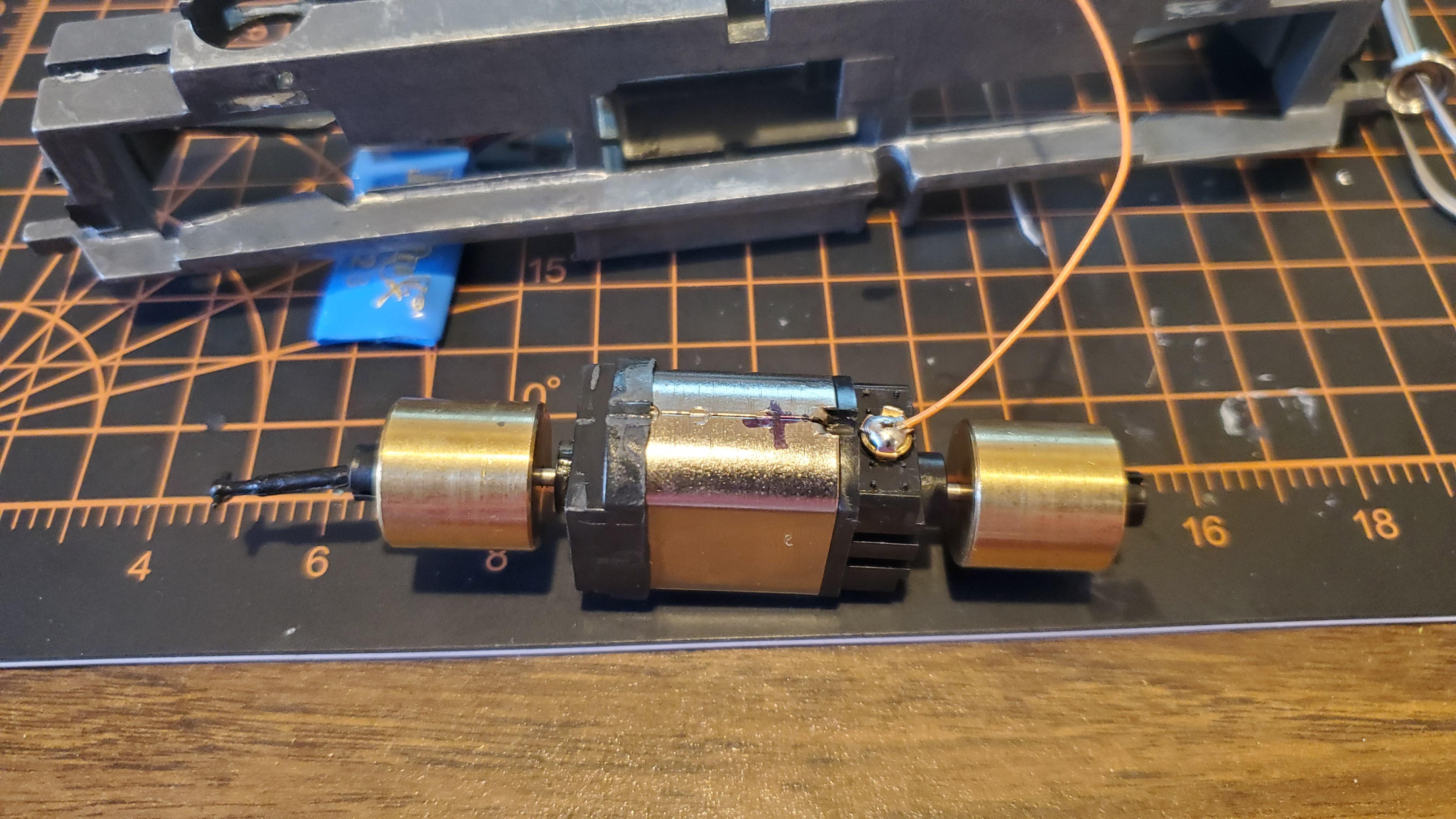
With a little more work, motor leads are in. I marked positive and negative, but in classic me fashion, I got them backwards, which will come into play later. Once the wires were in though, a clamped the track wires to my test track and tested the motor:
Yay! No burning decorder! From there, I did a test fit of the motor back into the shell, with the decoder, still mostly loose, up top. I also put electrical tape over the solder to prevent any accidental cross-wiring.
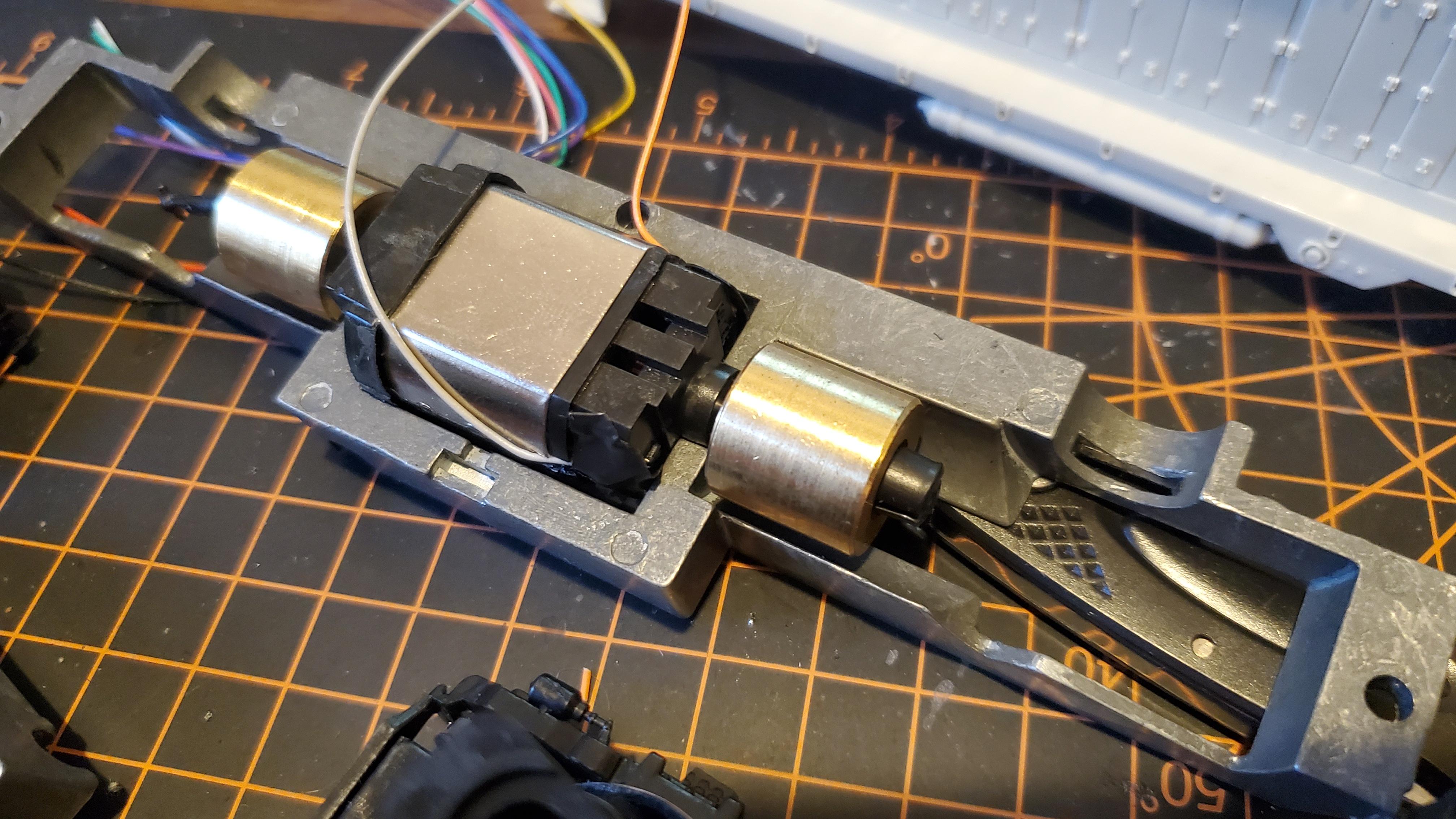
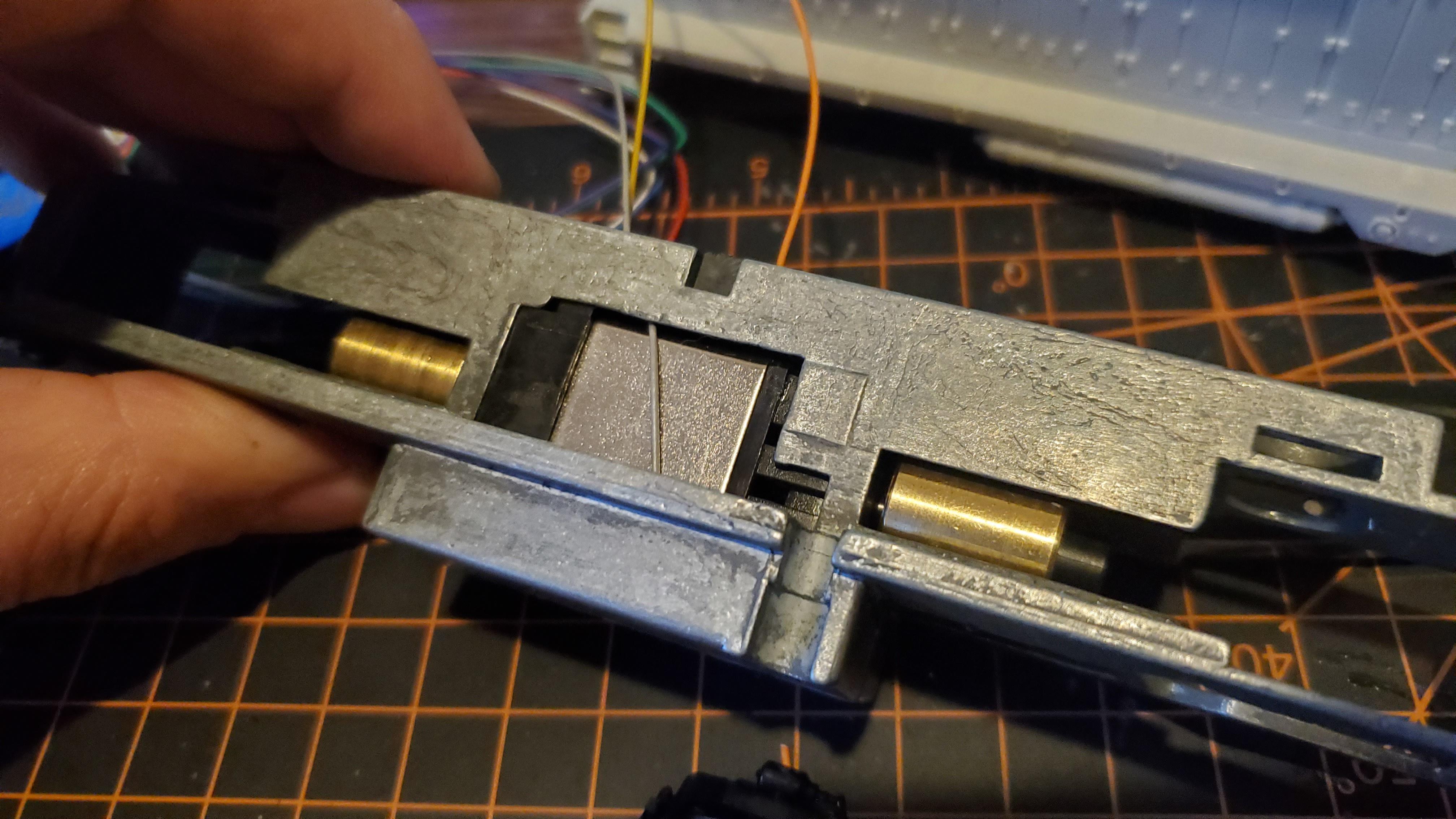
The motor fit in the weights without any issue, which was a pleasant surprise. However, mold tabs in the shell prevented the decoder from fitting just right. Thankfully they popped out with just a bit of extra force. (Note them in each of the 3 fan indents)
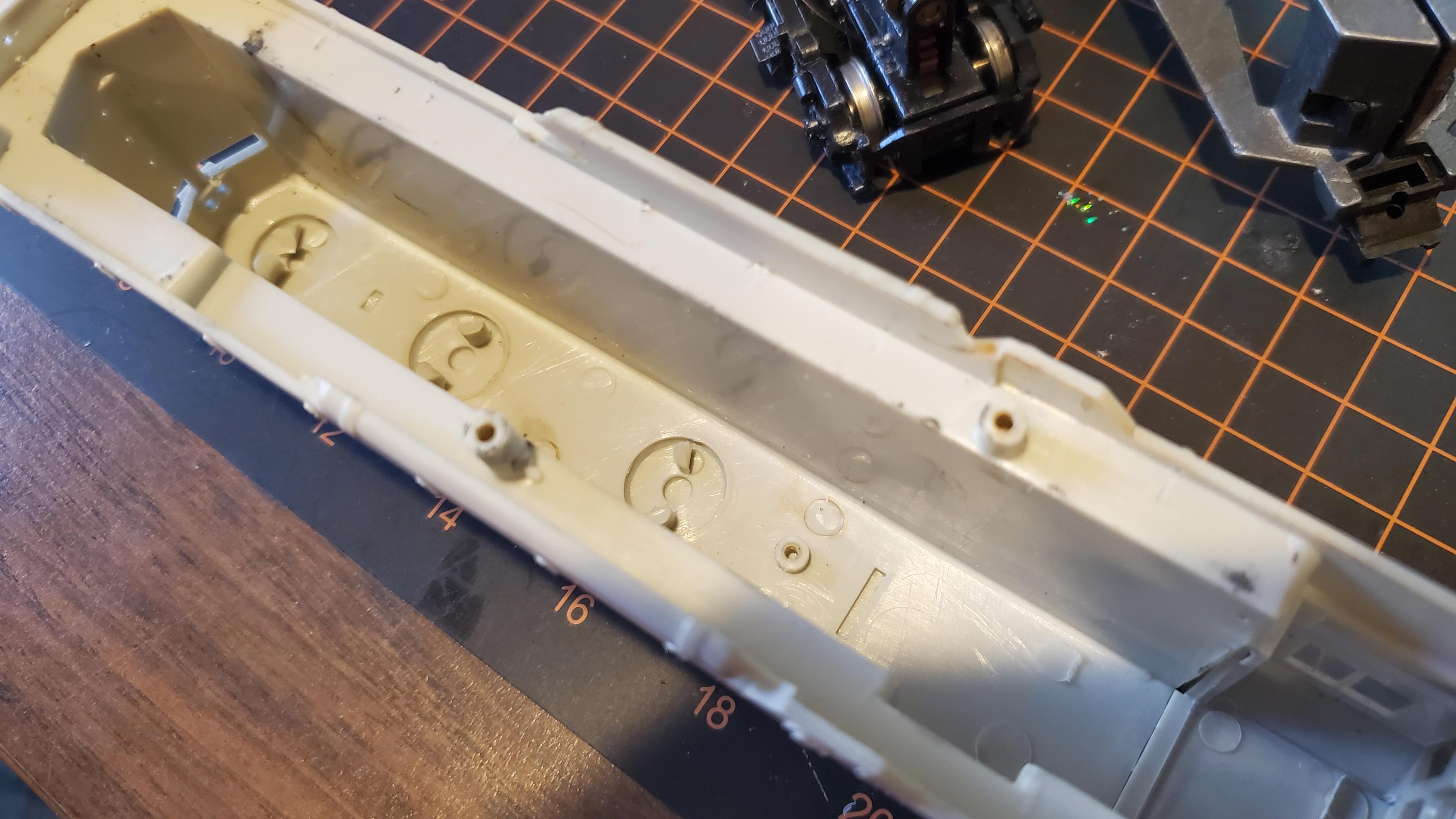
Motors in! Whats next?
Lights! I have some tiny little LEDs with resisters ready to go, so I used them here. Soldered them into the proper decoder wires and lightly glued them into the shell.
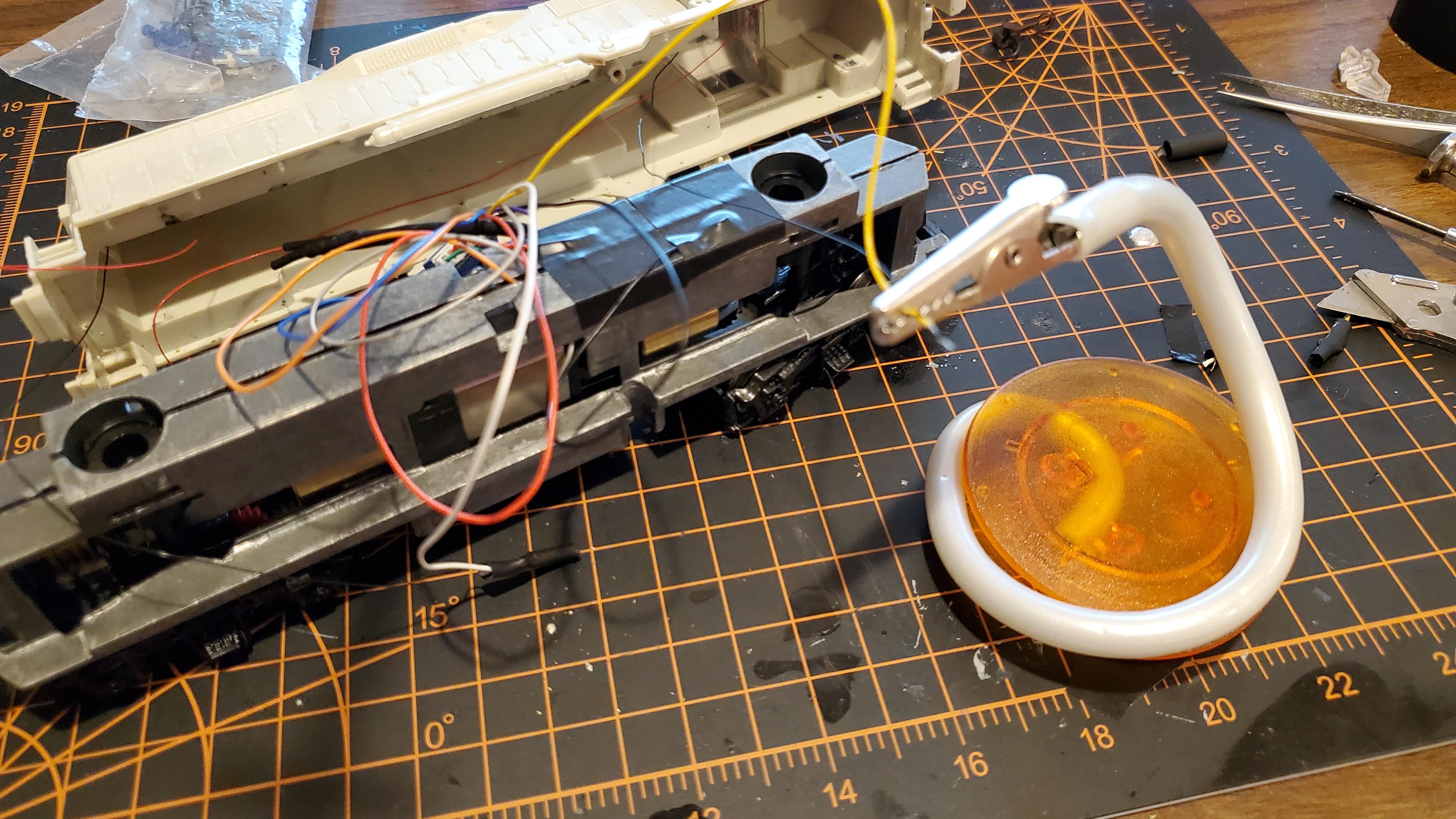
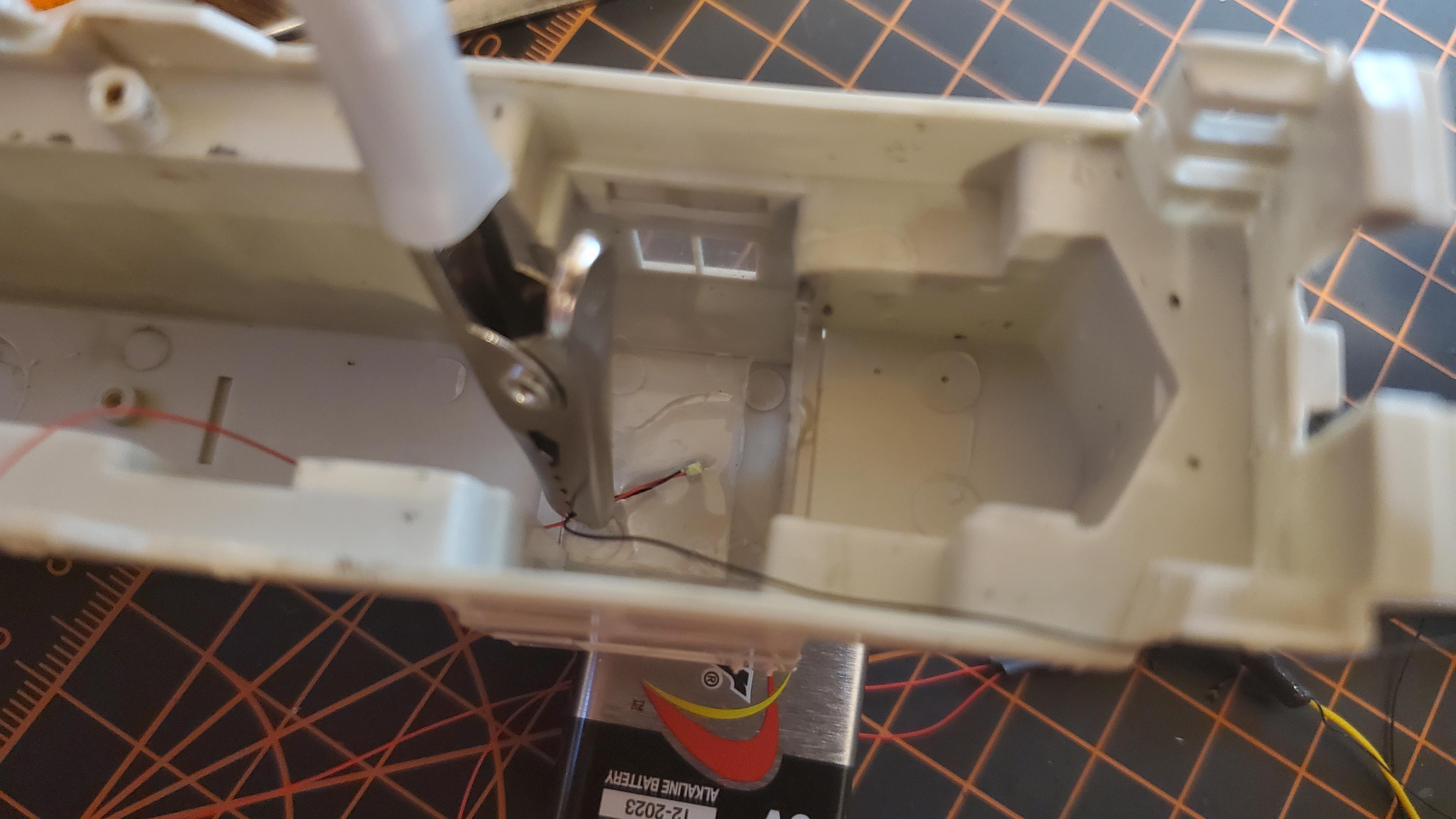
I had footage of them up and running, but it didn't save. Finally, I used electrical tape to tape the decoders 'track wires' to the two conductive weighted. With everything figuratively ready, I decided to shove everything into the shell and got the test loop out. Time for the first official test run!
Also a surprise from the Yard Master, Livy!
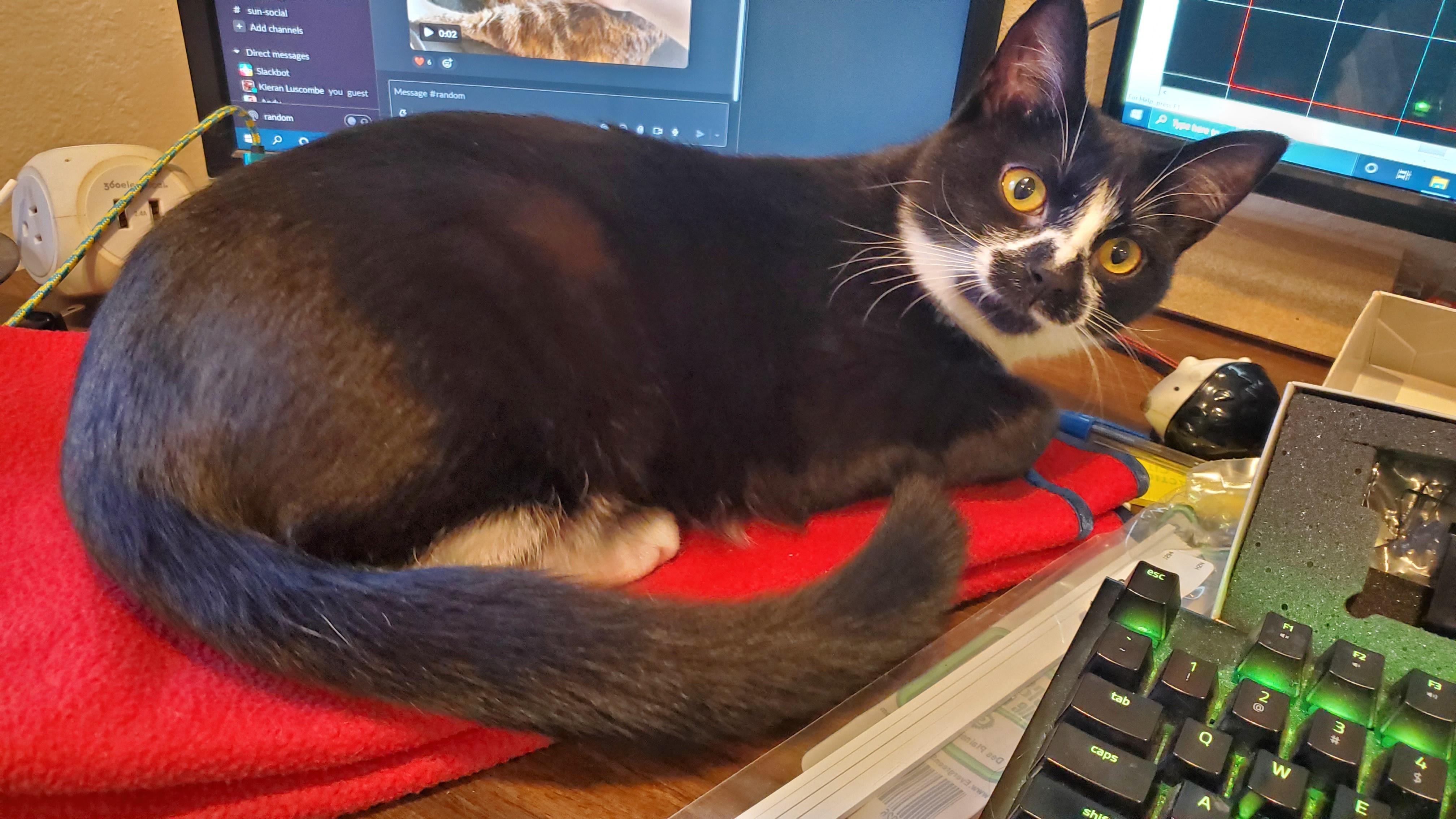
Uh oh! Looks like the motor power is backwards! Luckily I don't have to fully dismantle the thing to reverse the wires, a quick modification of CV (Controllable Variable) 29, and the motor is going 'forward' on forward, as intended. But this doesn't fix the lights, sadly. So everything back out again, and I spent some time rewiring the lights, simply inverting the connections so 'back is front' and 'front is back.'
At this point, I decided it would be best to detach the lights from the shell so I can paint it without worrying about any of the internals getting jammed up with paint. So I removed the shell and decided to do one last run to make sure I didn't break the rear LED, which I had to scrape off. (The front LED is glued to the window glass, which just pulls out with ease.
This is where I made the blunder.
While these little LEDS are great for fitting into tiny spaces, they have one problem: They're exposed. Normal LEDs have protective covering over the components, and the leads can be protected with shrink wrap. When I went to run the locomotive again, the exposed back of the rear LED touched the weight, which was talking in power from the track. This caused the decoder to short, and once the decoder shorts, it's good as dead (especially one like this, that has been out of production for years.)
I had a moment of panic; I thought I'd be spending another whole day redoing this entire process. As fun as soldering is, it can be exhausting, on top of the rest of the days 'to-do's.' Thankfully, the DH123D uses a 9-PIN Wire harness and is not directly wired in. Tomorrow, I'll just have to hit up the train store for a new decoder that can take a 9-PIN and simply swap out the chips (and after I finish this post, I'll make sure to 'protect' that LED with a coat of glue). So while ending on a low note, the days not totally bust! We'll see what tomorrow brings when I try and recreate the train's paint scheme on the shell!
Day 2
Original Goals for Saturday; paint the shell and purchase a new 9-PIN compatible decoder! Wish me luck!
Originally, I had intended on doing all the base painting for Saturday, so I could focus on Weathering on Sunday. The day started out with priming and...
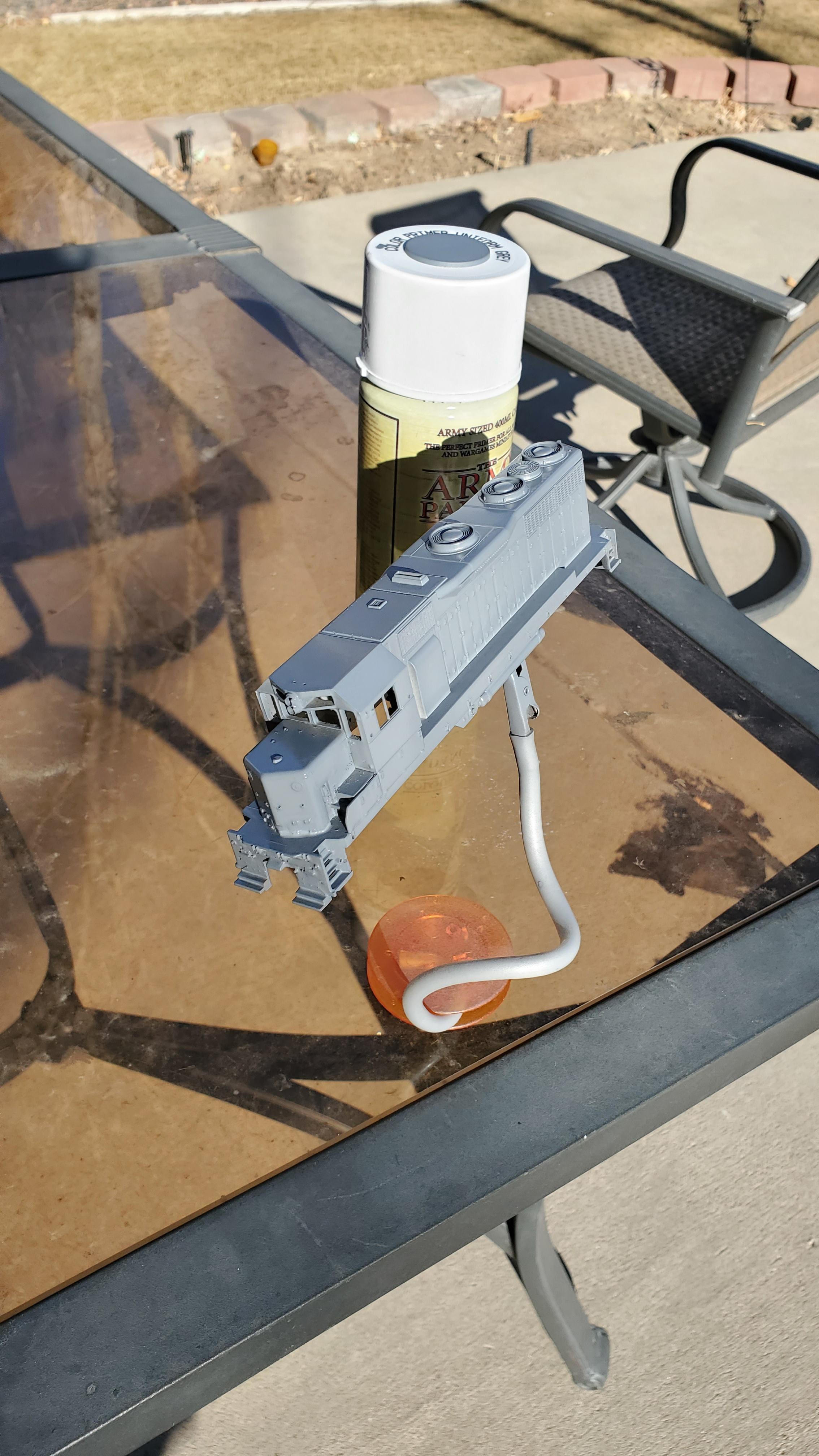
...a Covid Scare! I received confirmation that coworkers that I had been in recent contact with had the virus, so I had to spend the morning running a rapid test. Thankfully, the test came out as negative. The majority of the day was spent with fellow model railroad enthusiasts, and while I had intended on doing work on the locomotive, we never got around to it. I was kind of exhausted by the end of that and decided to drop Day 2 and just jam out on Sunday. I also missed the hobby stores hours, so I'll have to wait till Monday to get the replacement decoder.
Day 3
Original Goals for Saturday; do Saturday/Day 2's work and weather the locomotive
While the majority of the day was spent prepping for and hanging out with extended family (we do a craftmiss exchange which is rad) the afternoon hit me with an extra boost of energy, and I began the most important part of this project; paint job!
With the locomotive primed, I decided to start with a coat of orange, keeping the primers color for the grey I wanted. I marked off the areas to remain grey with tape.
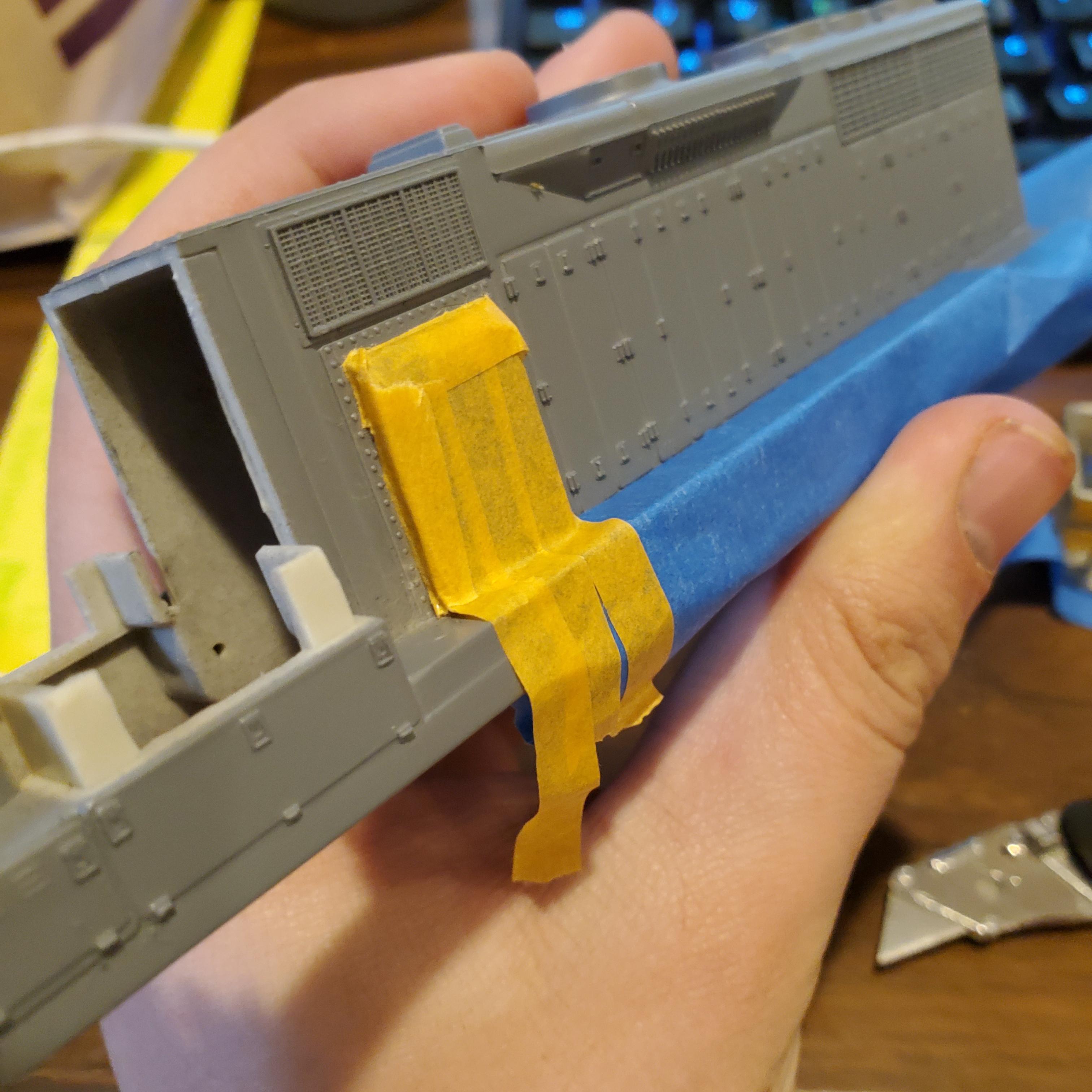

Easy enough, I used a bright orange airbrush color through the airbrush.
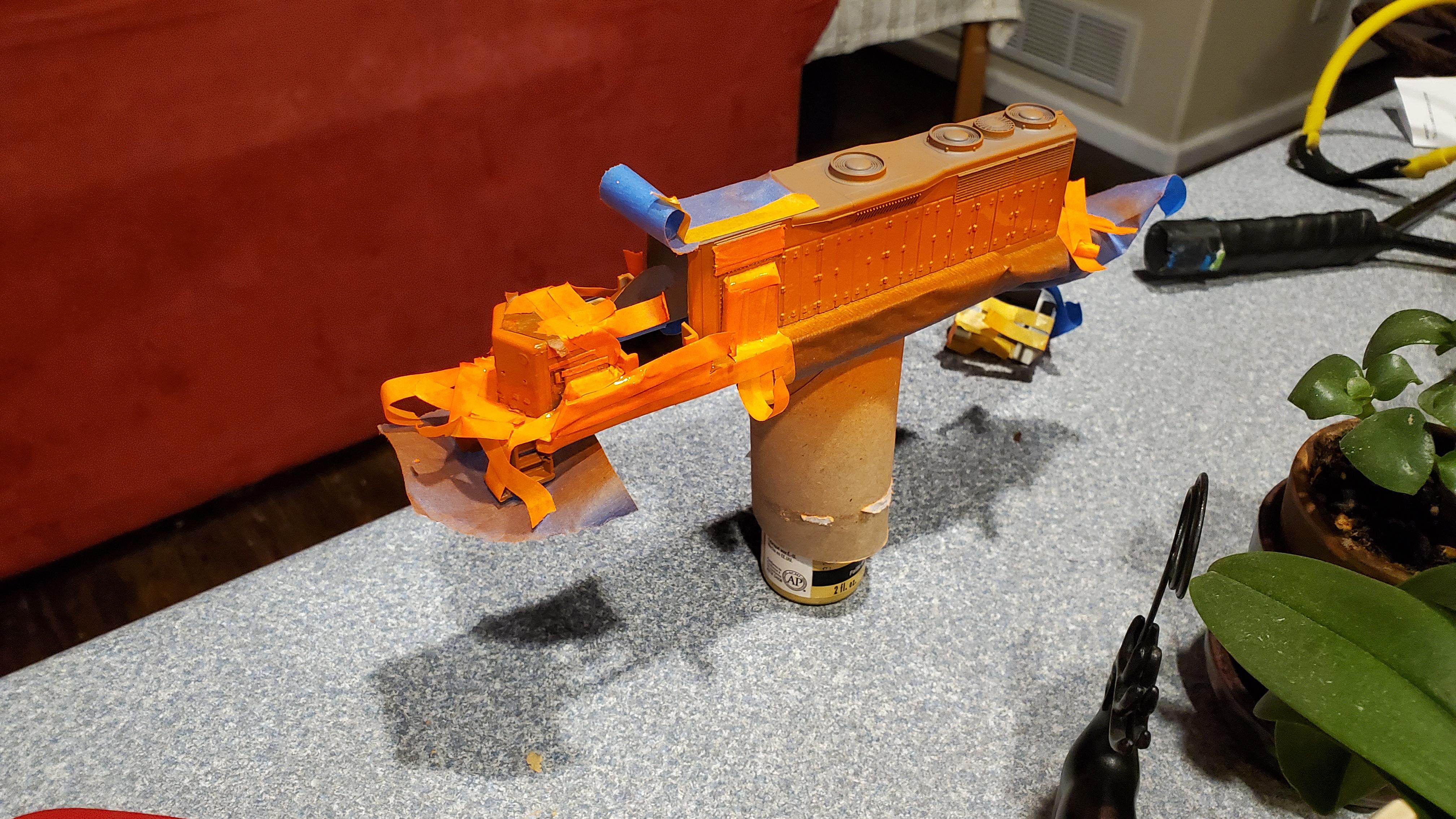
The stripe on the cab turned out well;
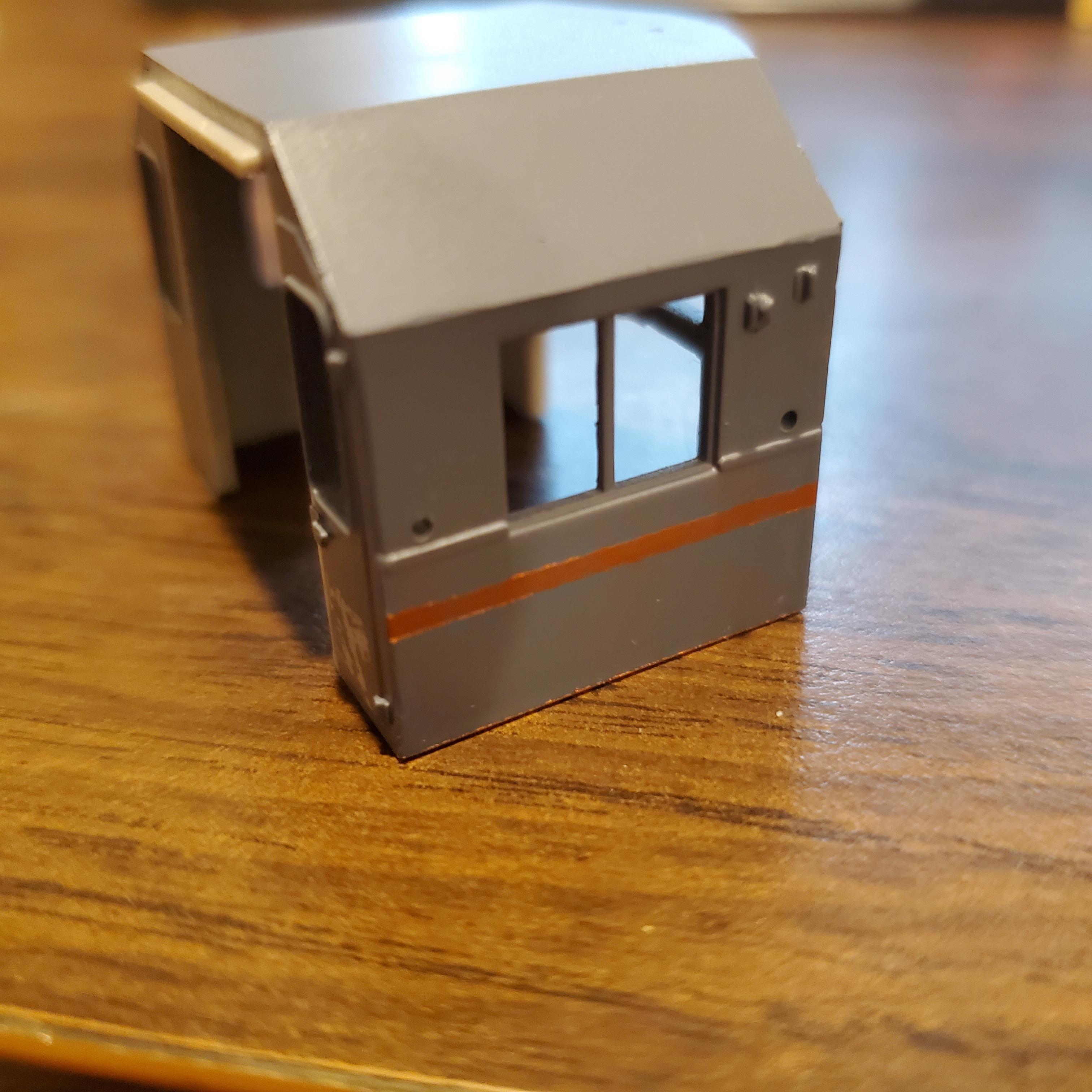
As well as the 'bloody nose!' At this point, I had also done a single coat of black along the back. The orange was bleeding through the black coat and looked rough.
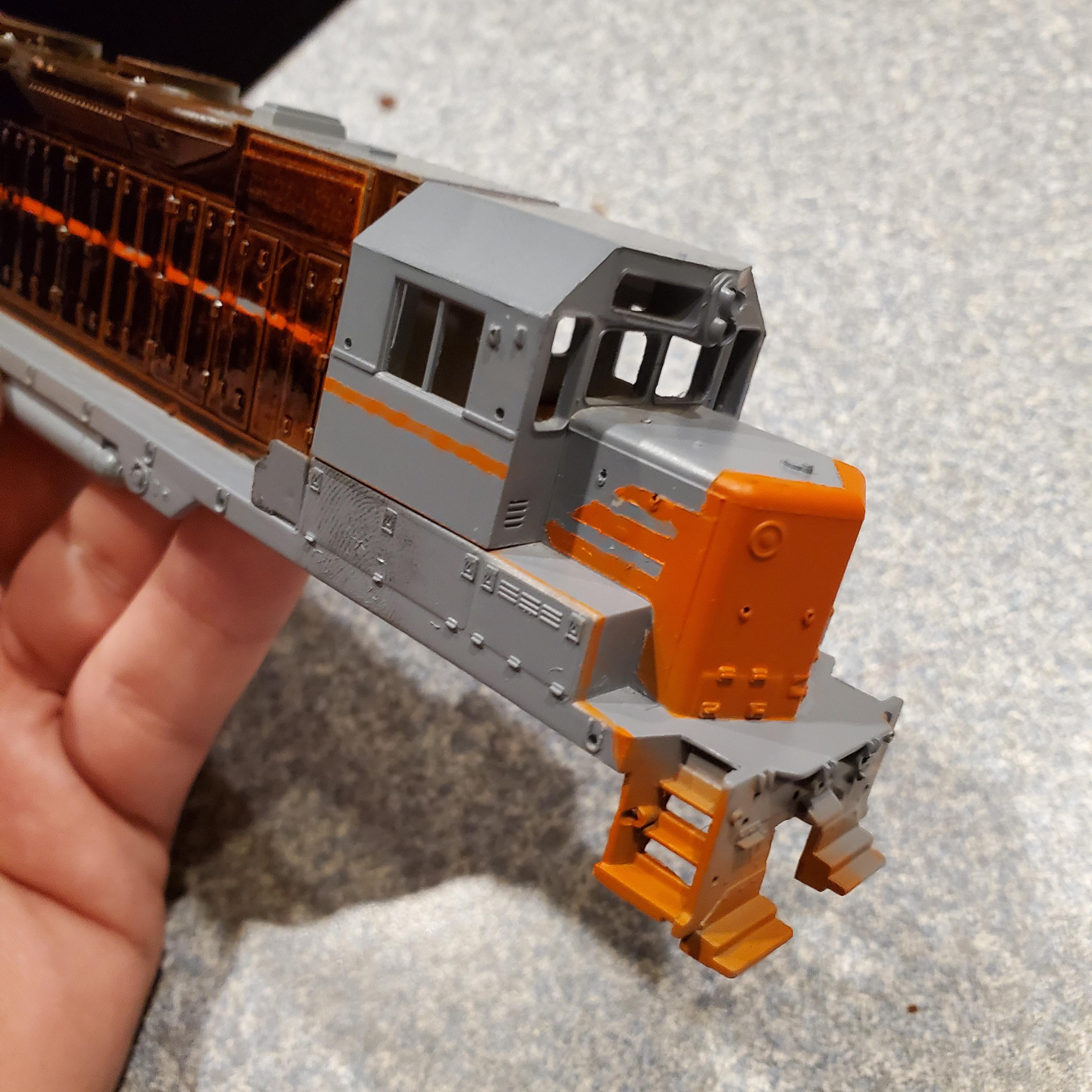
I decided to start over on the rear, removing the stripe paint and just full-blown black. I'll come in for the stripe later.
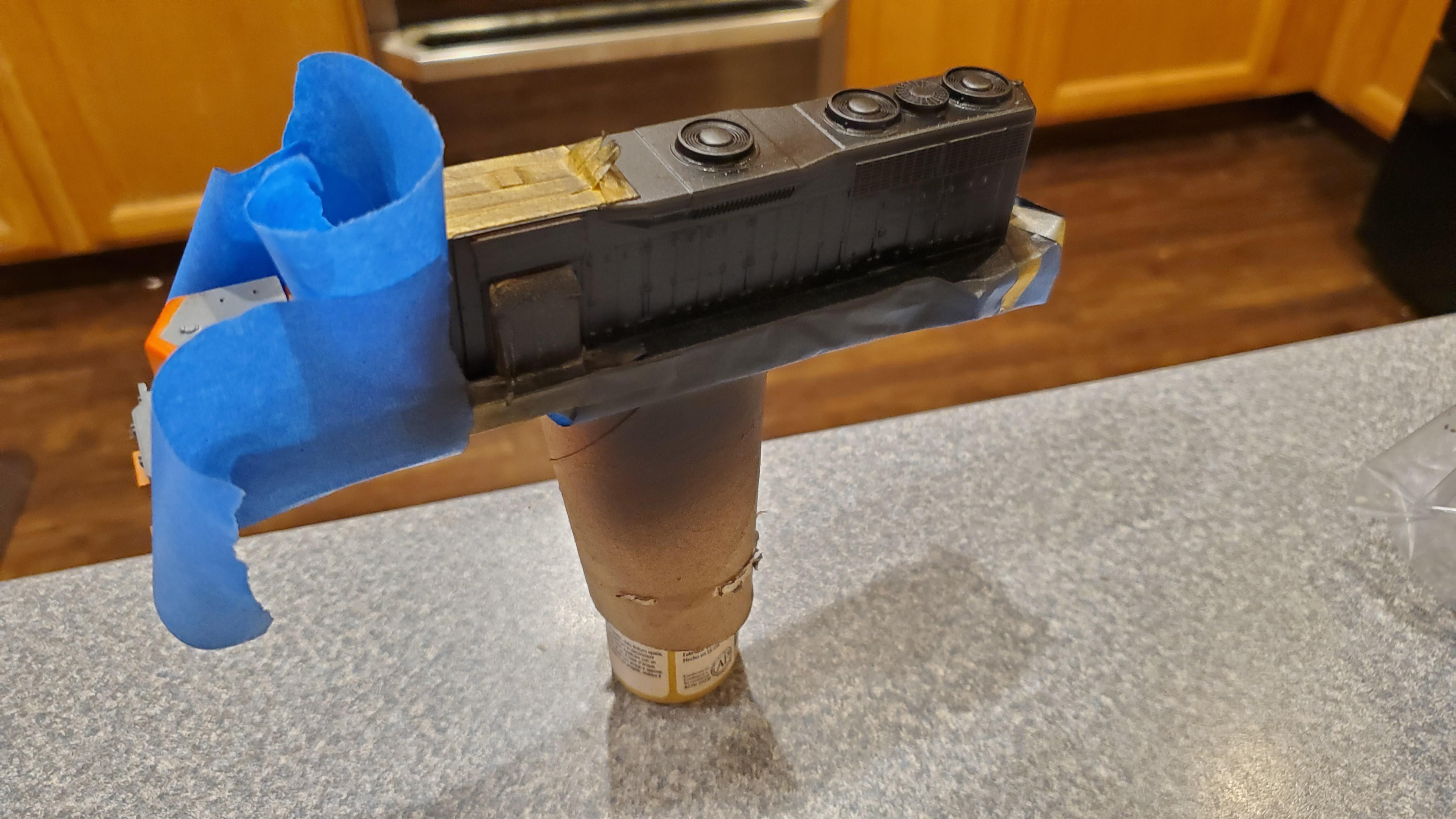
With 3 coats in total, the orange no longer bleeds through. Another layer of tape and another layer of orange and I've got a stripe in! Some paint chipped off, but it looks like a bit of weathering, and I cant be bothered to fix it.

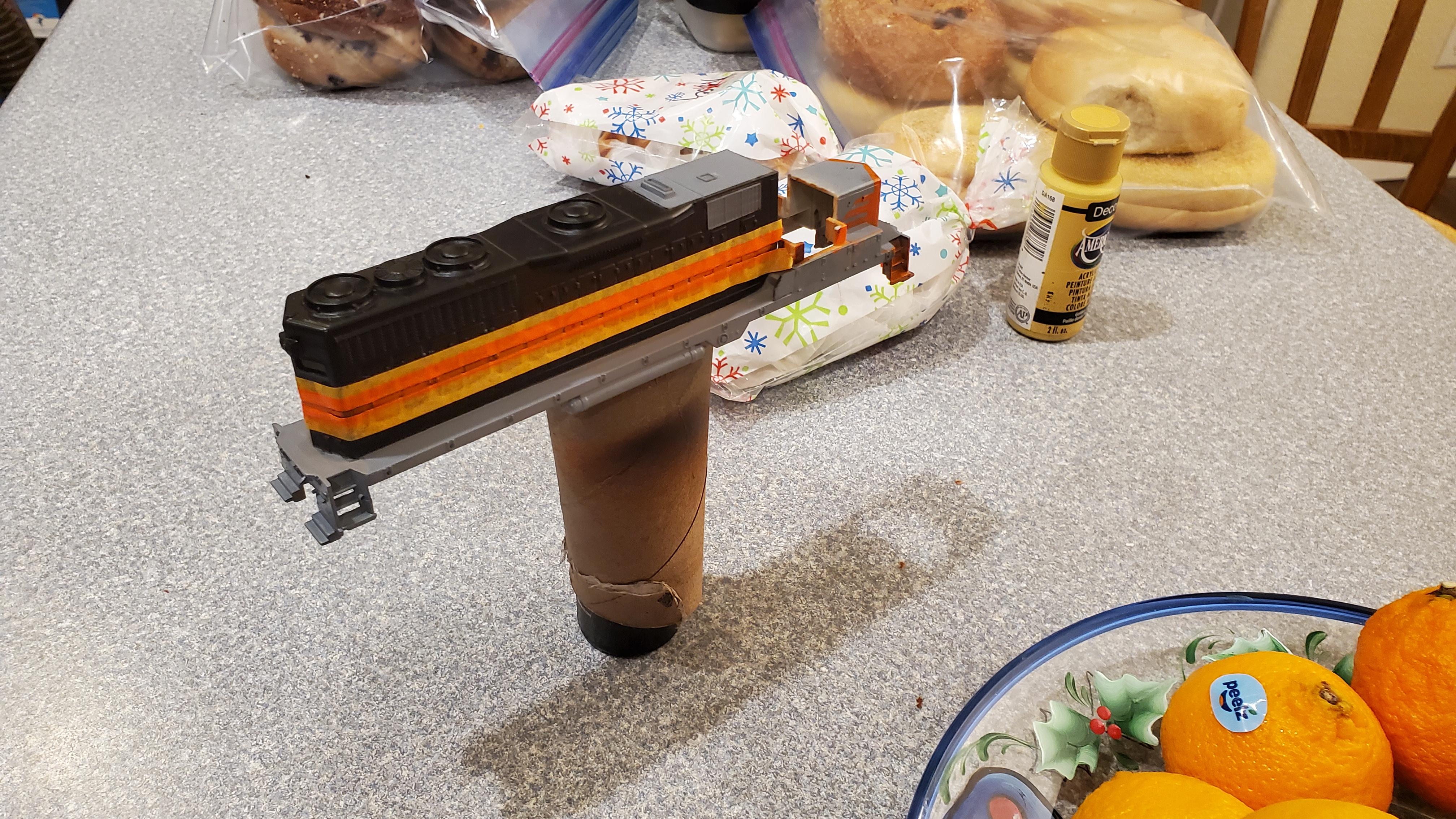
And thats the paint job finished!!!! You'll note some orange on the front ladder, I went back later and sprayed more primer, protecting the other paint with an index card. Real quick fixes.
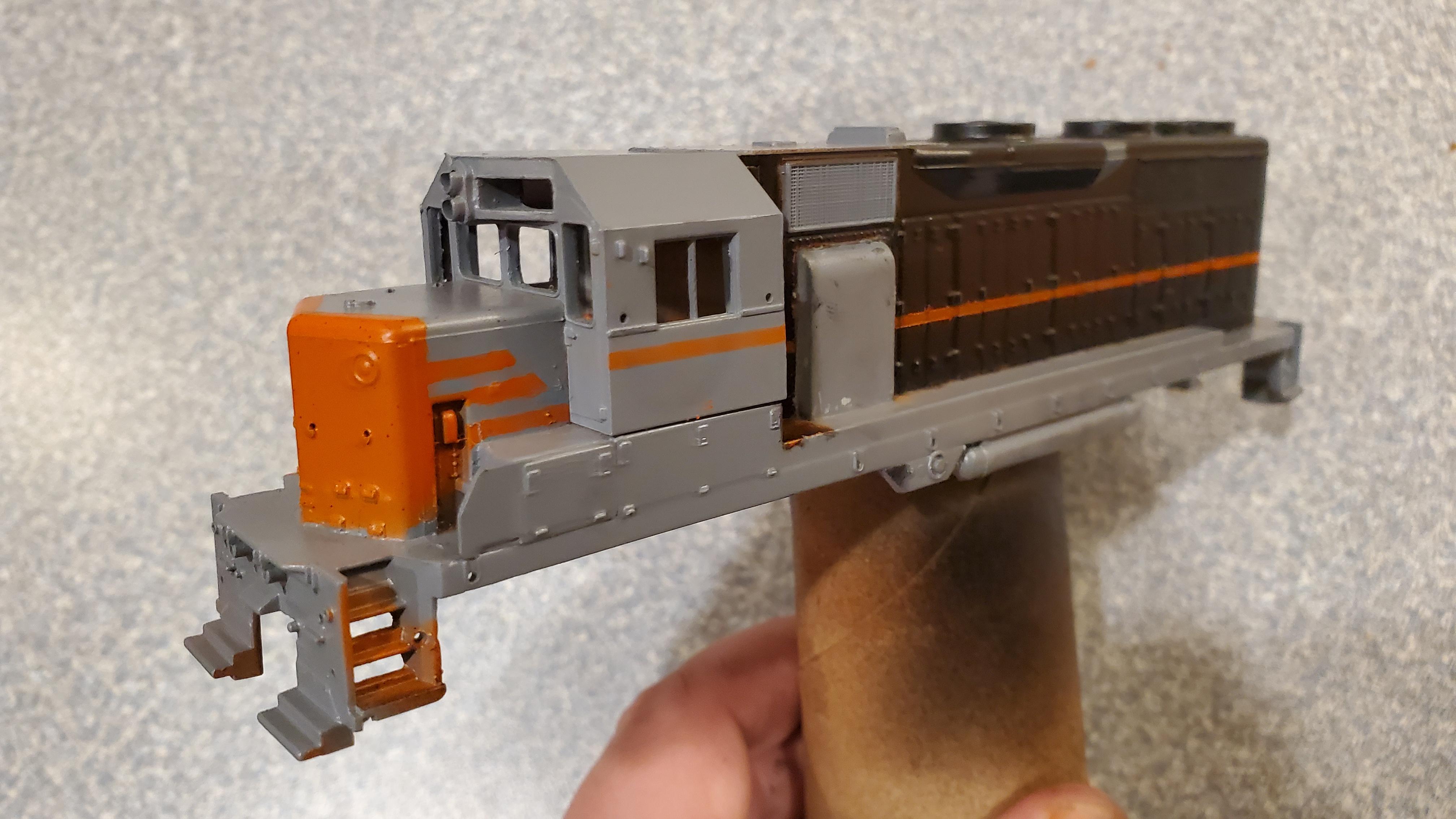
The next step was decals. The prototype model has 'Northern Express' written out with Northern above the stripe and Express small within the stripe. I've made the stripe way too small, and don't have the decals to write out Northern Express in white. So we'll have to take some creative liberties. Perhaps this locomotive, even if it will have the same number as the model, got a more temporary lettering before being finished?
Decalling was fairly easy, lots of adjusting of each individual letter to get it into position. The secret to positioning these is to add and remove the Micro Sol using a tissue to change how far the decal can move at once;
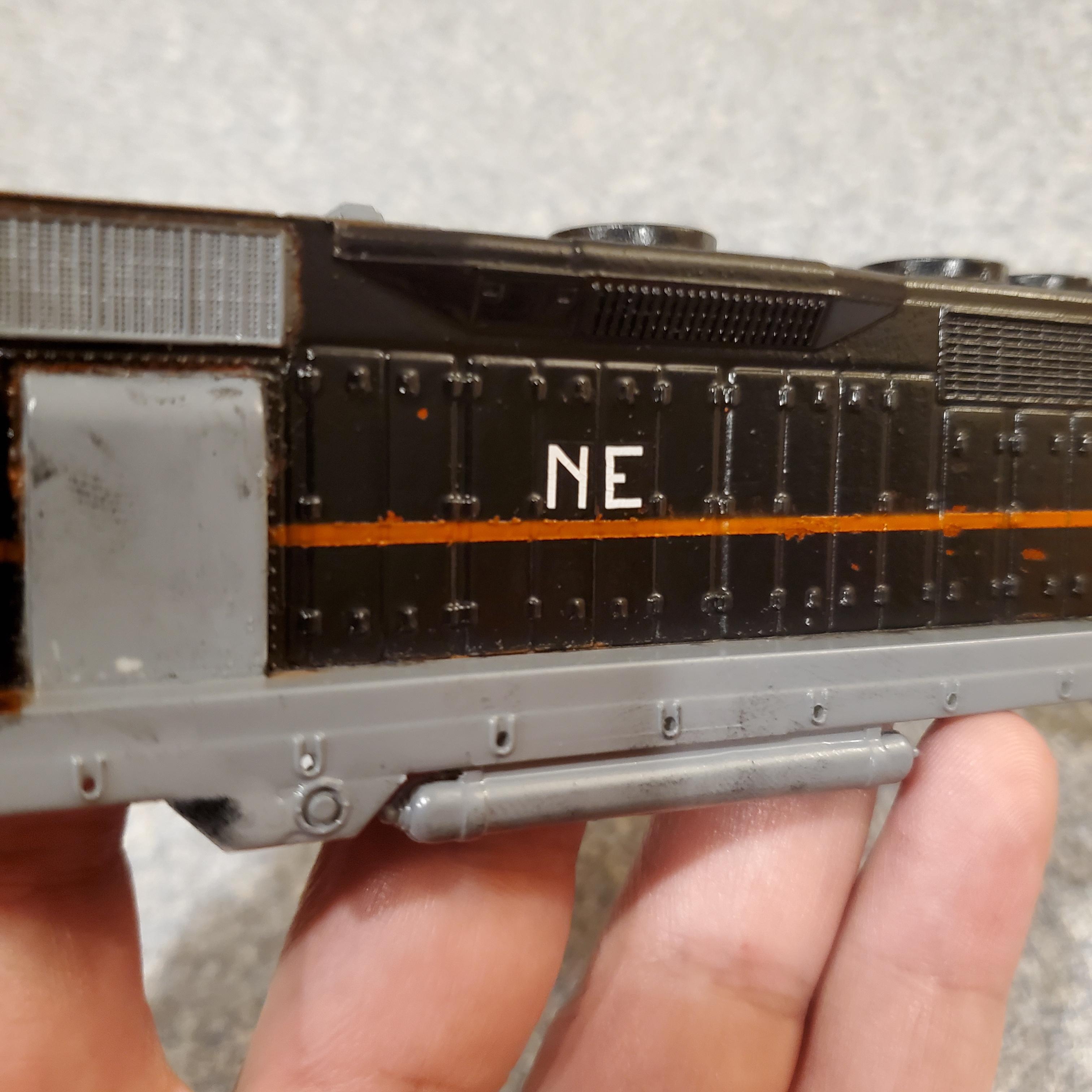
Finally, I coated the locomotive in a variety of weathering powders, giving it some extended depth. Nothing too detailed (and a lot of the detail was lost when I gave it a protective coat) but it's fine for this project.
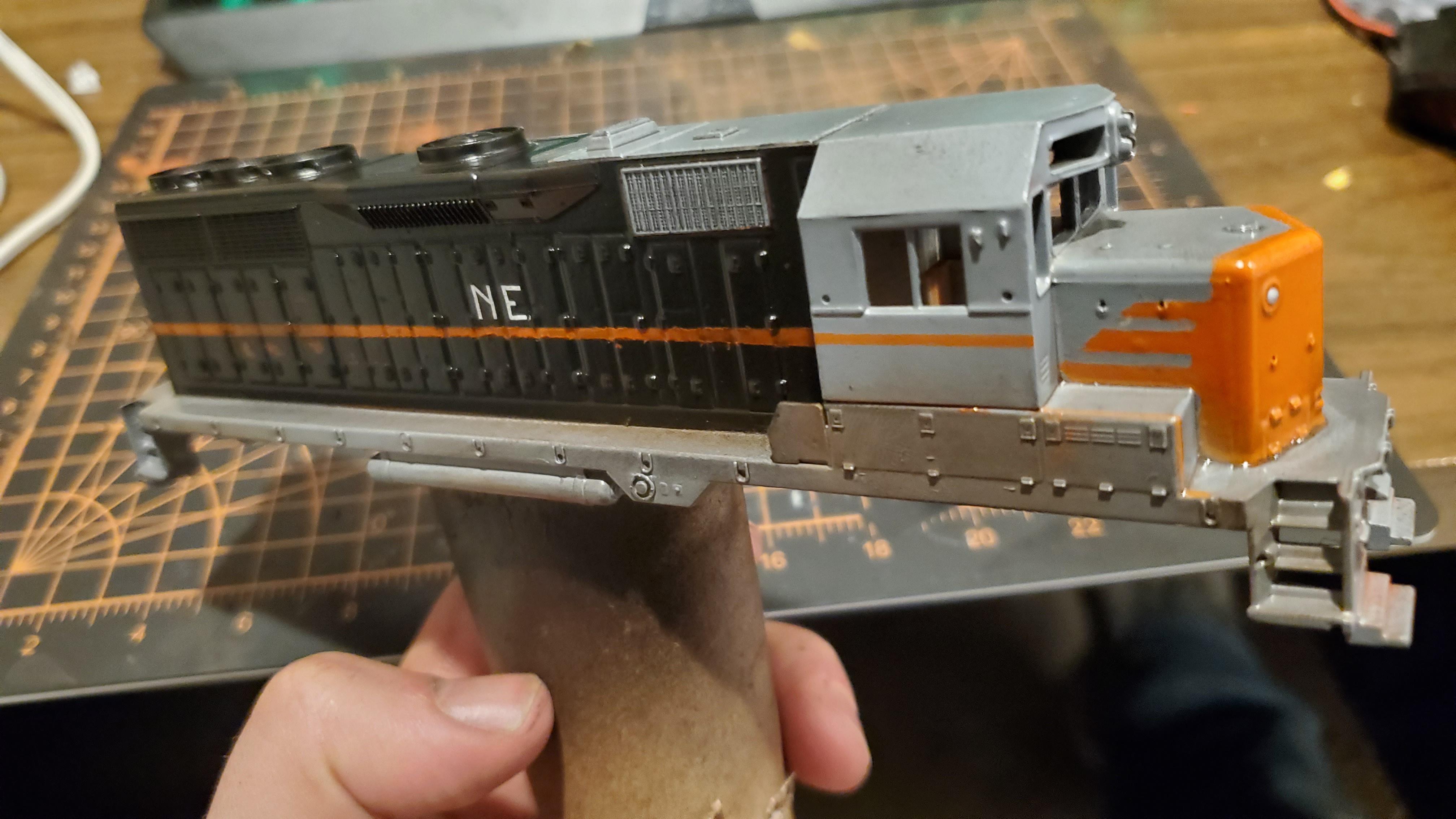
And there we go! Paint done!
To finish the day off, I added the horn and handrails. The horn on GP35's is normally above the headlights, but in the TF2 model, its pushed farther back on the cab. So I drilled new hole and moved them back. I wanted to do some of the smaller details, but I ran out of usable time, so I'm holding out for now. I also tried the number boards, but the method I could do in such short time didn't produce the results I wanted, so I'm holding off there as well.
Here is the final result for today! On the final day, I might do those extra details and will hit up the hobby shop for a new decoder. Otherwise, this has been an awesome project and I'm excited to write the retrospective tomorrow.
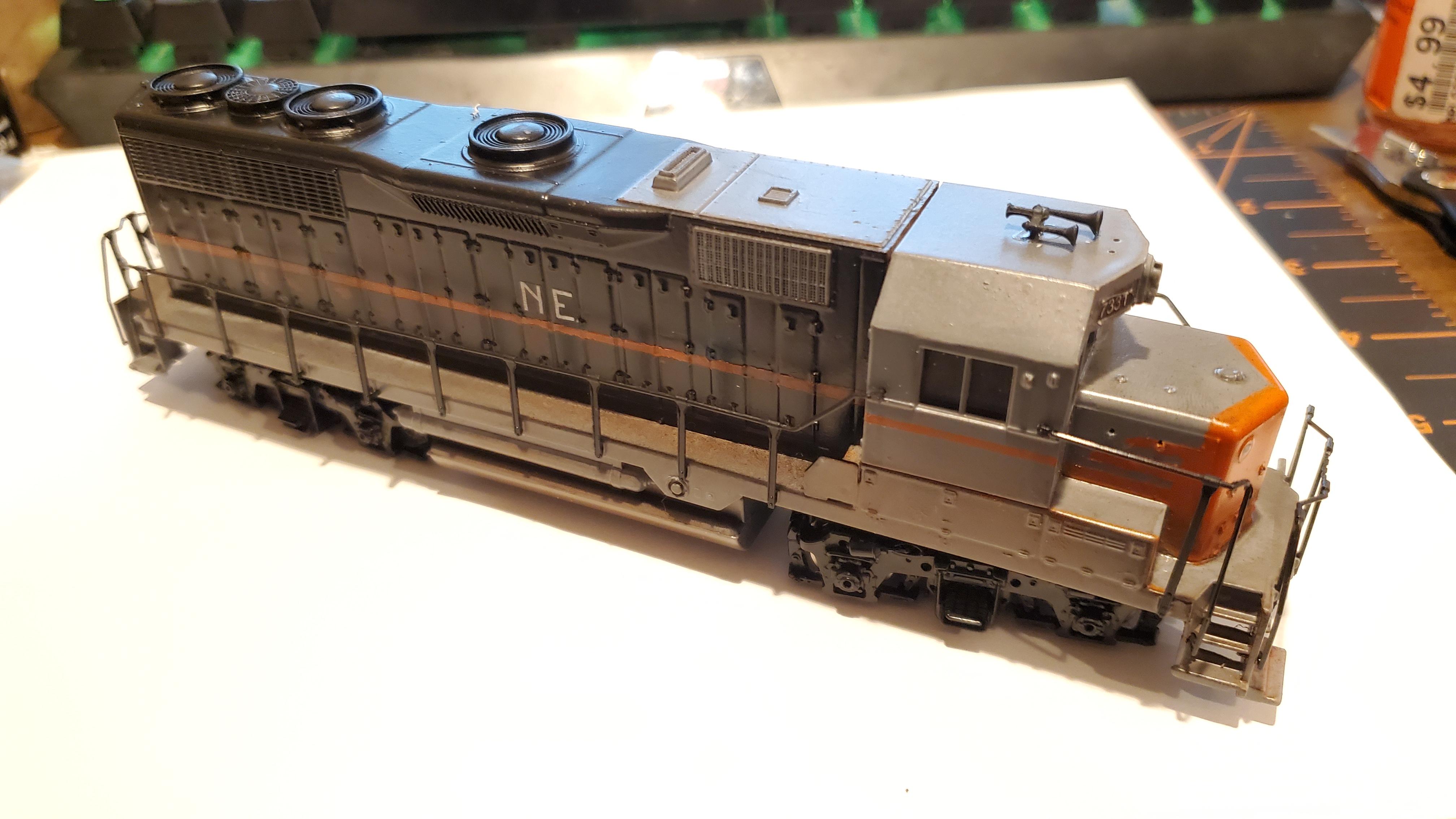
Day 4 (Half Day, Coming Soon!)
Original Goals for Monday; any more minor details such as ladders, couplers, number boards, as well as buy a new decoder.
Woke up fairly late this morning, and spent a bit of time trying some detailing work. I was able to get the couplers on, as well as two handrails. They take a lot of time to fit in, so I chose not to continue for now. I then took the locomotive outside for pictures, as time was almost up. Once I finish this update, I'll be going to buy that replacement decoder.
Here are the pictures of the 'jam complete' locomotive!
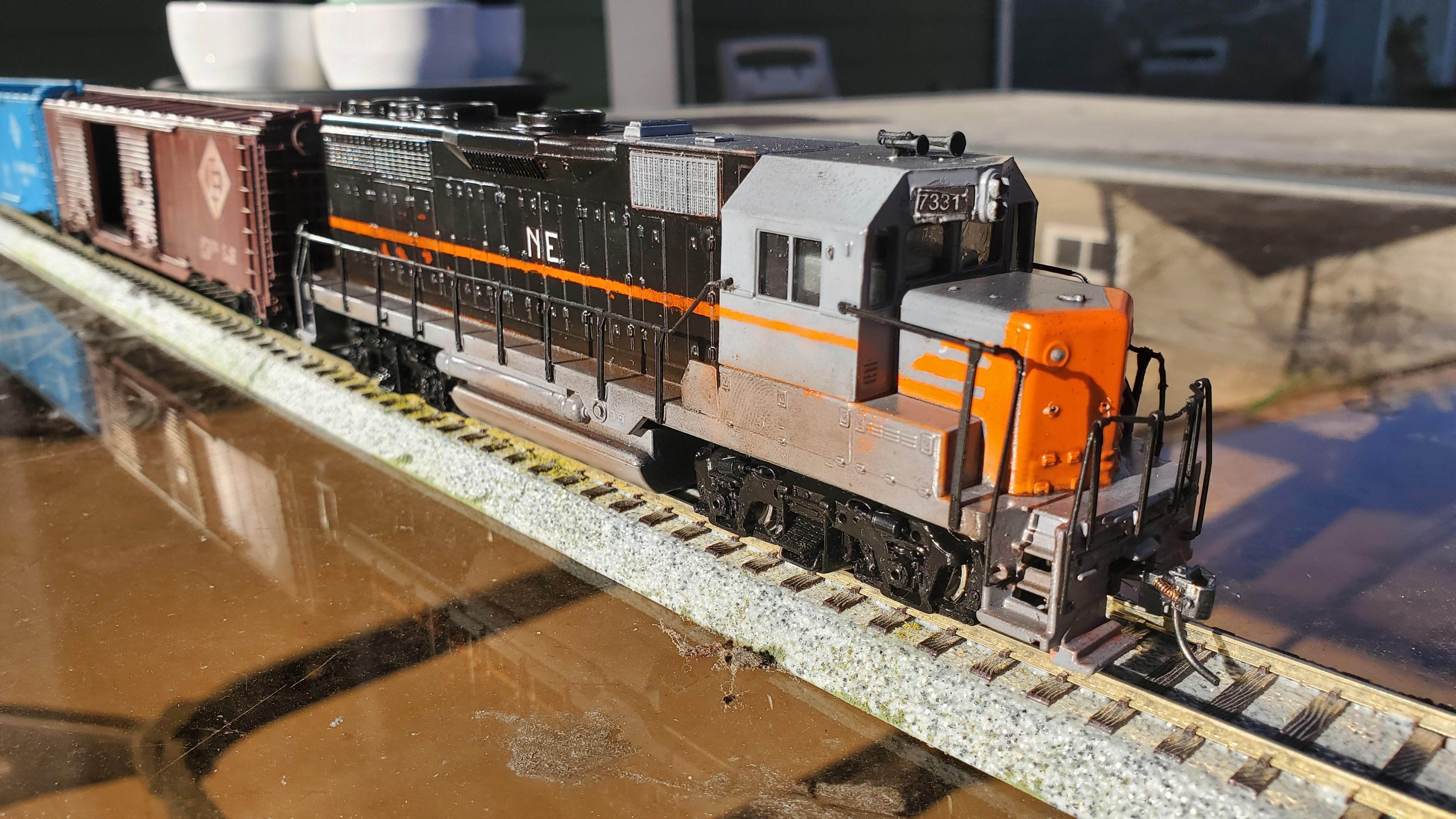
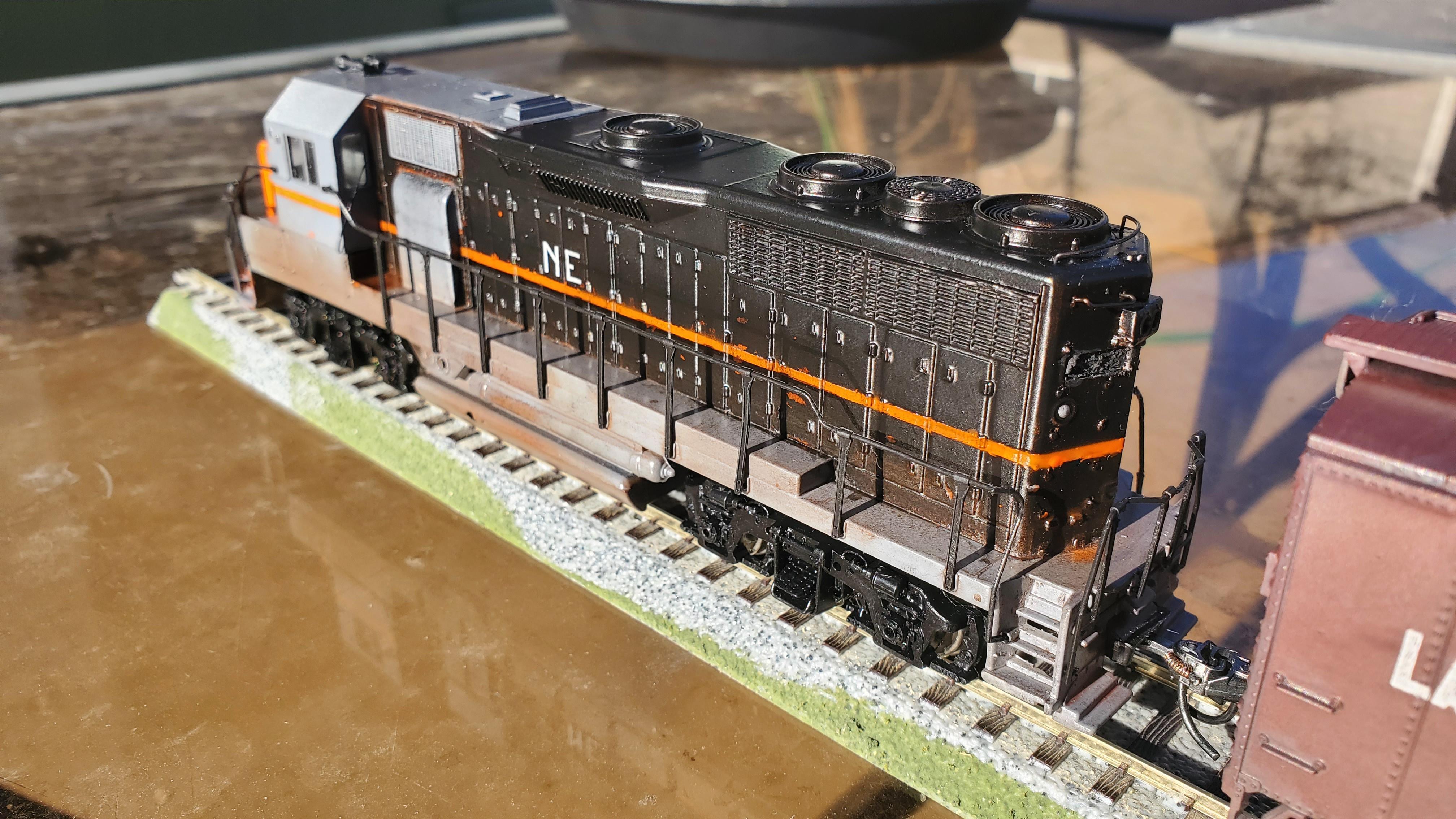

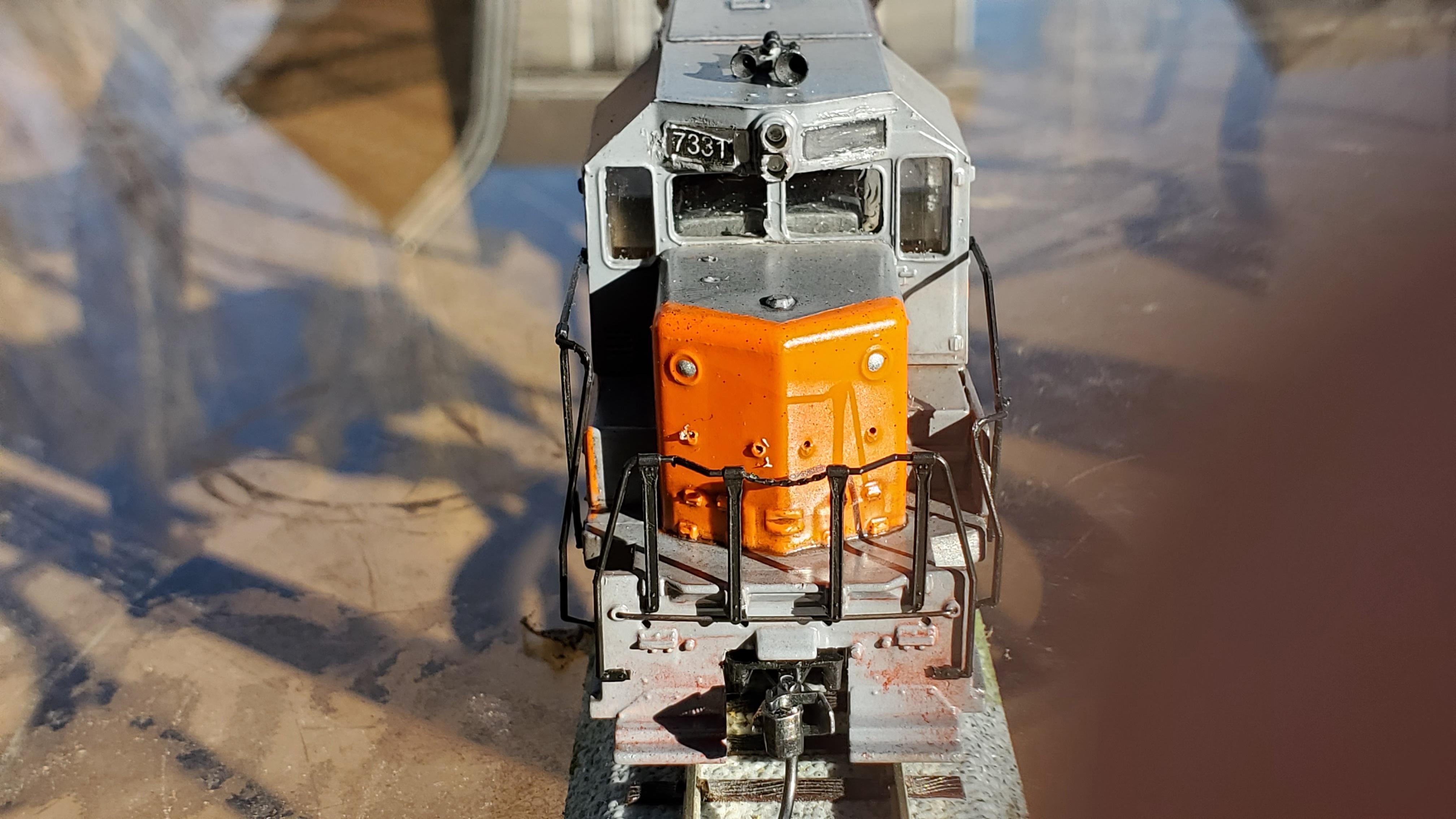
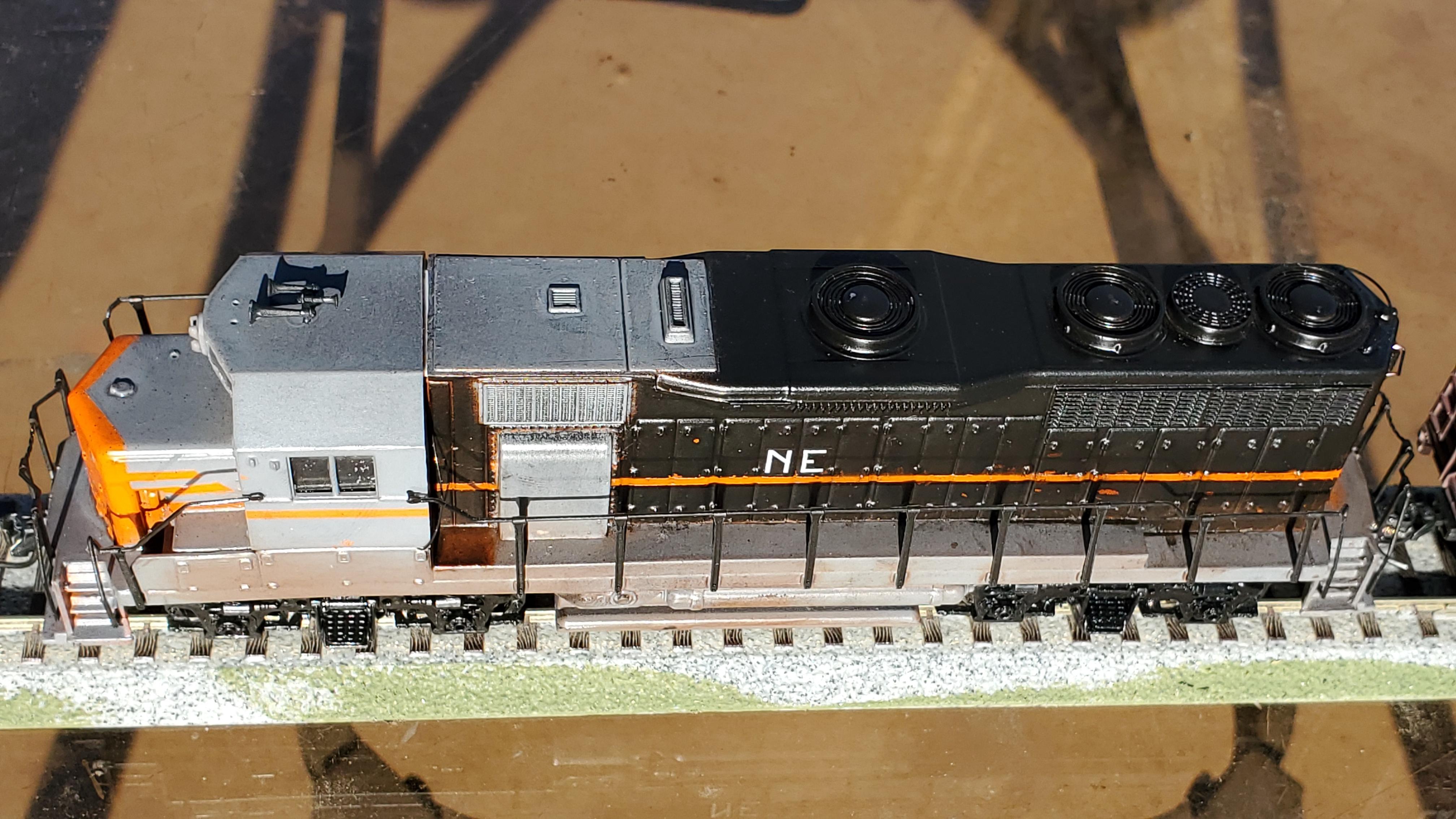
Thanks for following along!!!
Retrospective
I had a lot of fun on this project! For me, this is the first time I've ever painted a locomotive, so it was a lot of learning experiences. I'm really happy with how it turned out despite that lack of experience. I feel the weathering could be more pronounced; I only used powders, and their effect was heavily diminished by the protective clear coat. If I was to come back and do this project again, I would definitely wait for longer periods of time between paint coats, as I feel I was pealing paint off when removing tape more often than not.
I do wish I had more time throughout the Jam to work on it, but life is life. Cant always hyper-focus on one task. I strongly feel the time I did spend on the project was well spent, I didn't feel like I was 'spinning wheels' as I do on some map projects.
If there was one thing I would do differently, it would be how I approached the decoder. Frying it was a big disappointment and something that could be avoided. Using 'safer' LEDs that don't have exposed electronics is one safe guard I will use in the future. If I ever work on another Bachmann, I think I won't electrify the massive weights that take up the majority of the chassis, as they can be prone to issues. Instead, I'll directly wire into the trucks themselves. I'll also spend more time weathering and adding details.
So what's next for this project? While I may be done with this in terms of the jam, my favorite model rr quote is "your layout is never done." And thats true for this here as well. Including getting a new decoder in, which may have sound capabilities, we'll see; the replacement decoder may have more light options. I may drill out the silver 'reflector' lights and add flashing ditch lights. Beyond that, I plan on adding the rest of the included little details, and adding a grey 'beacon' to the top, something the in-game model has that I'm missing. Beyond that, another coat of Weathering, painting of the trucks, adding crew into the cab (I've got little blue men I'm gonna paint like the engineer) and anything else I find appropriate! I'll be sure to post those continued updates here, however, they will be in separate posts and not part of the main thread here.
Cheers! And Merry Smissmass!


Day 1 (Half Day)
This project starts with an existing locomotive: an undecorated Bachmann Plus EMD GP35. Not the flashiest locomotive, but a nice cheap start for a project like this. I obtained this last weekend from the local youth club, gave it a test run, then shelved it till the jam start.


Today's goal was to implement all the electronics, and prep the locomotive for painting tomorrow, at the club. The decoder I started with was a DigiTrax DH123D. An older decoder, but considering its been sitting in a box for about 8 years, what better time to use it than now?
Taking the shell off the locomotive reveals an interesting approach to the inner workings of a model train:

Older Bachmann locomotives, such as this one, consist of two driven trucks, driven by a can motor encased inside two large conductive weights. Power is passed from the tracks to the engine via these weights; the trucks contain little tabs that rub against the weight, transferring electricity through them to tabs on the motors. Some screws with rubber spaces hold everything together, making dismantling pretty easy.

First step of decoder installation was getting the leads (orange + grey) onto the motor. I cut the motor tabs off and soldered the wires to their point of origin. If you ever find yourself working on a similar mode, dont remove the caps, as they contain a spring that holds the whole thing together. I actually had to solder one cap into position as I went.

With a little more work, motor leads are in. I marked positive and negative, but in classic me fashion, I got them backwards, which will come into play later. Once the wires were in though, a clamped the track wires to my test track and tested the motor:


The motor fit in the weights without any issue, which was a pleasant surprise. However, mold tabs in the shell prevented the decoder from fitting just right. Thankfully they popped out with just a bit of extra force. (Note them in each of the 3 fan indents)

Motors in! Whats next?
Lights! I have some tiny little LEDs with resisters ready to go, so I used them here. Soldered them into the proper decoder wires and lightly glued them into the shell.


I had footage of them up and running, but it didn't save. Finally, I used electrical tape to tape the decoders 'track wires' to the two conductive weighted. With everything figuratively ready, I decided to shove everything into the shell and got the test loop out. Time for the first official test run!

Uh oh! Looks like the motor power is backwards! Luckily I don't have to fully dismantle the thing to reverse the wires, a quick modification of CV (Controllable Variable) 29, and the motor is going 'forward' on forward, as intended. But this doesn't fix the lights, sadly. So everything back out again, and I spent some time rewiring the lights, simply inverting the connections so 'back is front' and 'front is back.'
This is where I made the blunder.
While these little LEDS are great for fitting into tiny spaces, they have one problem: They're exposed. Normal LEDs have protective covering over the components, and the leads can be protected with shrink wrap. When I went to run the locomotive again, the exposed back of the rear LED touched the weight, which was talking in power from the track. This caused the decoder to short, and once the decoder shorts, it's good as dead (especially one like this, that has been out of production for years.)
I had a moment of panic; I thought I'd be spending another whole day redoing this entire process. As fun as soldering is, it can be exhausting, on top of the rest of the days 'to-do's.' Thankfully, the DH123D uses a 9-PIN Wire harness and is not directly wired in. Tomorrow, I'll just have to hit up the train store for a new decoder that can take a 9-PIN and simply swap out the chips (and after I finish this post, I'll make sure to 'protect' that LED with a coat of glue). So while ending on a low note, the days not totally bust! We'll see what tomorrow brings when I try and recreate the train's paint scheme on the shell!
Day 2
Original Goals for Saturday; paint the shell and purchase a new 9-PIN compatible decoder! Wish me luck!
Originally, I had intended on doing all the base painting for Saturday, so I could focus on Weathering on Sunday. The day started out with priming and...

...a Covid Scare! I received confirmation that coworkers that I had been in recent contact with had the virus, so I had to spend the morning running a rapid test. Thankfully, the test came out as negative. The majority of the day was spent with fellow model railroad enthusiasts, and while I had intended on doing work on the locomotive, we never got around to it. I was kind of exhausted by the end of that and decided to drop Day 2 and just jam out on Sunday. I also missed the hobby stores hours, so I'll have to wait till Monday to get the replacement decoder.
Day 3
Original Goals for Saturday; do Saturday/Day 2's work and weather the locomotive
While the majority of the day was spent prepping for and hanging out with extended family (we do a craftmiss exchange which is rad) the afternoon hit me with an extra boost of energy, and I began the most important part of this project; paint job!
With the locomotive primed, I decided to start with a coat of orange, keeping the primers color for the grey I wanted. I marked off the areas to remain grey with tape.


Easy enough, I used a bright orange airbrush color through the airbrush.

The stripe on the cab turned out well;

As well as the 'bloody nose!' At this point, I had also done a single coat of black along the back. The orange was bleeding through the black coat and looked rough.

I decided to start over on the rear, removing the stripe paint and just full-blown black. I'll come in for the stripe later.

With 3 coats in total, the orange no longer bleeds through. Another layer of tape and another layer of orange and I've got a stripe in! Some paint chipped off, but it looks like a bit of weathering, and I cant be bothered to fix it.


And thats the paint job finished!!!! You'll note some orange on the front ladder, I went back later and sprayed more primer, protecting the other paint with an index card. Real quick fixes.

The next step was decals. The prototype model has 'Northern Express' written out with Northern above the stripe and Express small within the stripe. I've made the stripe way too small, and don't have the decals to write out Northern Express in white. So we'll have to take some creative liberties. Perhaps this locomotive, even if it will have the same number as the model, got a more temporary lettering before being finished?
Decalling was fairly easy, lots of adjusting of each individual letter to get it into position. The secret to positioning these is to add and remove the Micro Sol using a tissue to change how far the decal can move at once;

Finally, I coated the locomotive in a variety of weathering powders, giving it some extended depth. Nothing too detailed (and a lot of the detail was lost when I gave it a protective coat) but it's fine for this project.

And there we go! Paint done!
To finish the day off, I added the horn and handrails. The horn on GP35's is normally above the headlights, but in the TF2 model, its pushed farther back on the cab. So I drilled new hole and moved them back. I wanted to do some of the smaller details, but I ran out of usable time, so I'm holding out for now. I also tried the number boards, but the method I could do in such short time didn't produce the results I wanted, so I'm holding off there as well.
Here is the final result for today! On the final day, I might do those extra details and will hit up the hobby shop for a new decoder. Otherwise, this has been an awesome project and I'm excited to write the retrospective tomorrow.

Day 4 (Half Day, Coming Soon!)
Original Goals for Monday; any more minor details such as ladders, couplers, number boards, as well as buy a new decoder.
Woke up fairly late this morning, and spent a bit of time trying some detailing work. I was able to get the couplers on, as well as two handrails. They take a lot of time to fit in, so I chose not to continue for now. I then took the locomotive outside for pictures, as time was almost up. Once I finish this update, I'll be going to buy that replacement decoder.
Here are the pictures of the 'jam complete' locomotive!





Thanks for following along!!!
Retrospective
I had a lot of fun on this project! For me, this is the first time I've ever painted a locomotive, so it was a lot of learning experiences. I'm really happy with how it turned out despite that lack of experience. I feel the weathering could be more pronounced; I only used powders, and their effect was heavily diminished by the protective clear coat. If I was to come back and do this project again, I would definitely wait for longer periods of time between paint coats, as I feel I was pealing paint off when removing tape more often than not.
I do wish I had more time throughout the Jam to work on it, but life is life. Cant always hyper-focus on one task. I strongly feel the time I did spend on the project was well spent, I didn't feel like I was 'spinning wheels' as I do on some map projects.
If there was one thing I would do differently, it would be how I approached the decoder. Frying it was a big disappointment and something that could be avoided. Using 'safer' LEDs that don't have exposed electronics is one safe guard I will use in the future. If I ever work on another Bachmann, I think I won't electrify the massive weights that take up the majority of the chassis, as they can be prone to issues. Instead, I'll directly wire into the trucks themselves. I'll also spend more time weathering and adding details.
So what's next for this project? While I may be done with this in terms of the jam, my favorite model rr quote is "your layout is never done." And thats true for this here as well. Including getting a new decoder in, which may have sound capabilities, we'll see; the replacement decoder may have more light options. I may drill out the silver 'reflector' lights and add flashing ditch lights. Beyond that, I plan on adding the rest of the included little details, and adding a grey 'beacon' to the top, something the in-game model has that I'm missing. Beyond that, another coat of Weathering, painting of the trucks, adding crew into the cab (I've got little blue men I'm gonna paint like the engineer) and anything else I find appropriate! I'll be sure to post those continued updates here, however, they will be in separate posts and not part of the main thread here.
Cheers! And Merry Smissmass!
